Crew-3 (Crew-3 mission on SpaceX’s Crew Dragon spacecraft)
Human Spaceflight
Related resources
Crew-3 mission on SpaceX’s Crew Dragon spacecraft
The Crew-3 flight will carry NASA astronauts Raja Chari, mission commander; Tom Marshburn, pilot; and Kayla Barron, mission specialist; as well as ESA (European Space Agency) astronaut Matthias Maurer, who will serve as a mission specialist, to the space station for a six-month science mission. 1) 2) 3)
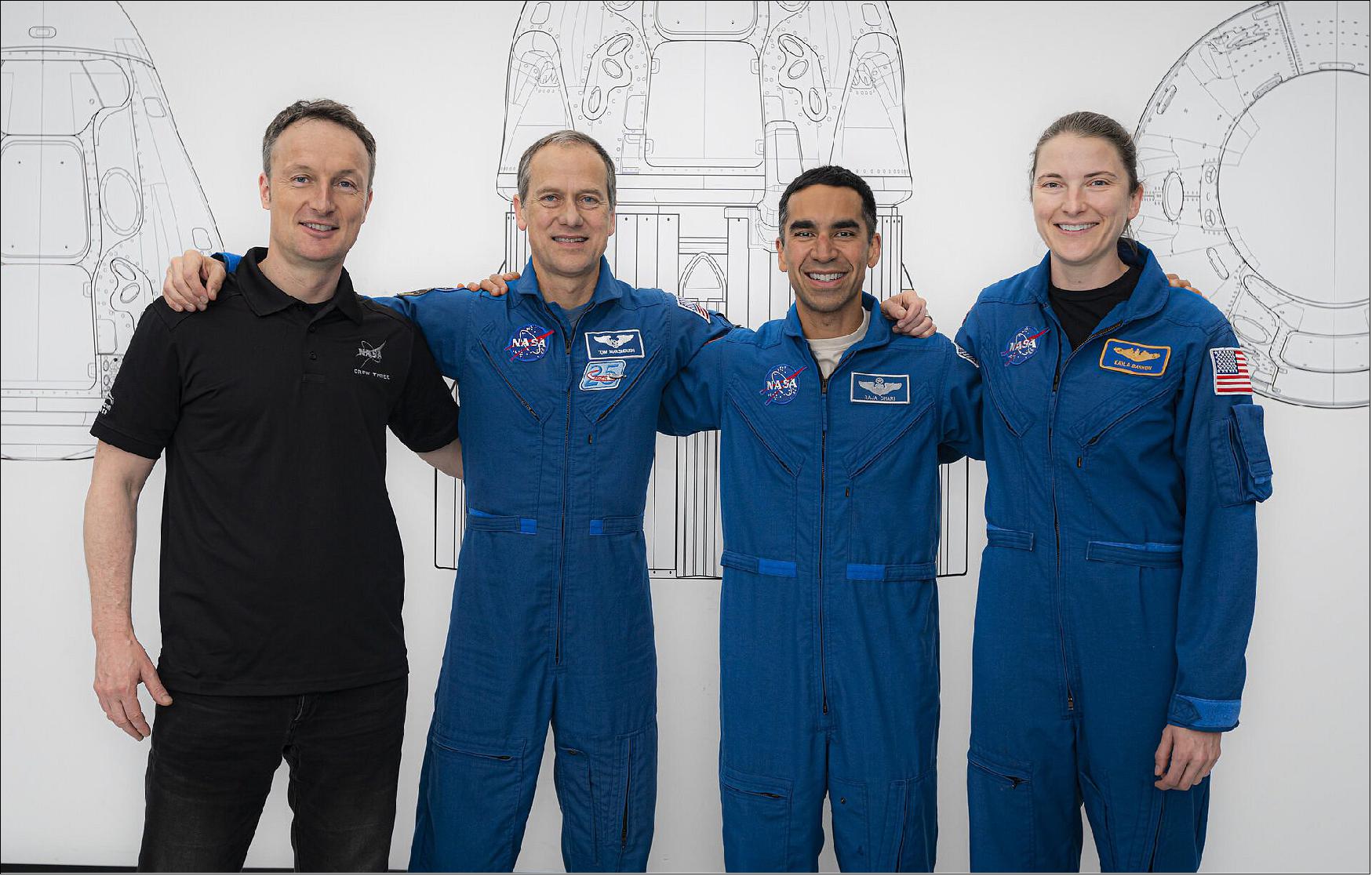
- Raja Chari is commander of the Crew Dragon spacecraft and the Crew-3 mission. Chari is responsible for all phases of flight, from launch to re-entry. He also will serve as an Expedition 66 flight engineer aboard the station. This will be the first spaceflight for Chari, who was selected as a NASA astronaut candidate in 2017. He was born in Milwaukee, but considers Cedar Falls, Iowa, his hometown. He is a colonel in the U.S. Air Force and joins the mission with extensive experience as a test pilot. He has accumulated more than 2,500 hours of flight time in his career. Chari was also selected as a member of the Artemis Team and is now eligible for assignment to a future lunar mission.
- Tom Marshburn is the pilot of the Crew Dragon spacecraft and second-in-command for the mission. He is responsible for spacecraft systems and performance. Once aboard station, he will serve as an Expedition 66 flight engineer,and is scheduled to assume command of station for Expedition 67. Marshburn is a Statesville, North Carolina, native who became an astronaut in 2004. Prior to serving in the astronaut corps, the medical doctor served as flight surgeon at NASA’s Johnson Space Center in Houston and later became medical operations lead for the International Space Station. The Crew-3 mission will be his third visit to the space station on three different spacecraft and his second long-duration mission. Marshburn previously served as a crew member of STS-127 in 2009 flying aboard NASA’s Space Shuttle Endeavour, and Expedition 34/35, which concluded in 2013, using a Russian Soyuz spacecraft.
- Kayla Barron is a mission specialist for Crew-3. As a mission specialist, she will work closely with the commander and pilot to monitor the spacecraft during the dynamic launch and re-entry phases of flight. Once aboard the station, she will become a flight engineer for Expedition 66. Barron was born in Pocatello, Idaho, but considers Richland, Washington, her hometown. She earned a bachelor’s degree in systems engineering from the U.S. Naval Academy in Annapolis, Maryland, in 2010, and a master’s degree in nuclear engineering from the University of Cambridge, in England, in 2011, as a Gates Cambridge Scholar. Lt. Cmdr. Barron earned her submarine warfare officer qualification and deployed three times while serving aboard the USS Maine. At the time of her selection as an astronaut candidate in 2017, she was serving as the flag aide to the superintendent of the U.S. Naval Academy. Crew-3 will be Barron’s first spaceflight.
- Matthias Maurer officially joined ESA’s Astronaut Corps in 2015 and is the only ESA astronaut yet to fly to space. Originally from the southwest German state of Saarland, Matthias has studied in four different countries, gained a doctorate in materials science engineering and achieved national recognition for outstanding research. In 2016, Maurer spent 16 days on an undersea mission as part of a NASA’s Extreme Environment Mission Operations (NEEMO), space analog.
Cosmic Kiss mission: German ESA astronaut Matthias Maurer will soon begin his first mission to the International Space Station. As a member of Crew-3, he will be launched from NASA’s Kennedy Space Center in a SpaceX Crew Dragon spacecraft alongside NASA astronauts Raja Chari, Tom Marshburn and Kayla Barron. 4)
Figure 2: Matthias selected the mission name “Cosmic Kiss” for his time in orbit as a declaration of love for space. He will spend around six months living and working in microgravity, where he will carry out many European and international experiments to advance space exploration and benefit lives on Earth (video credit: ESA)
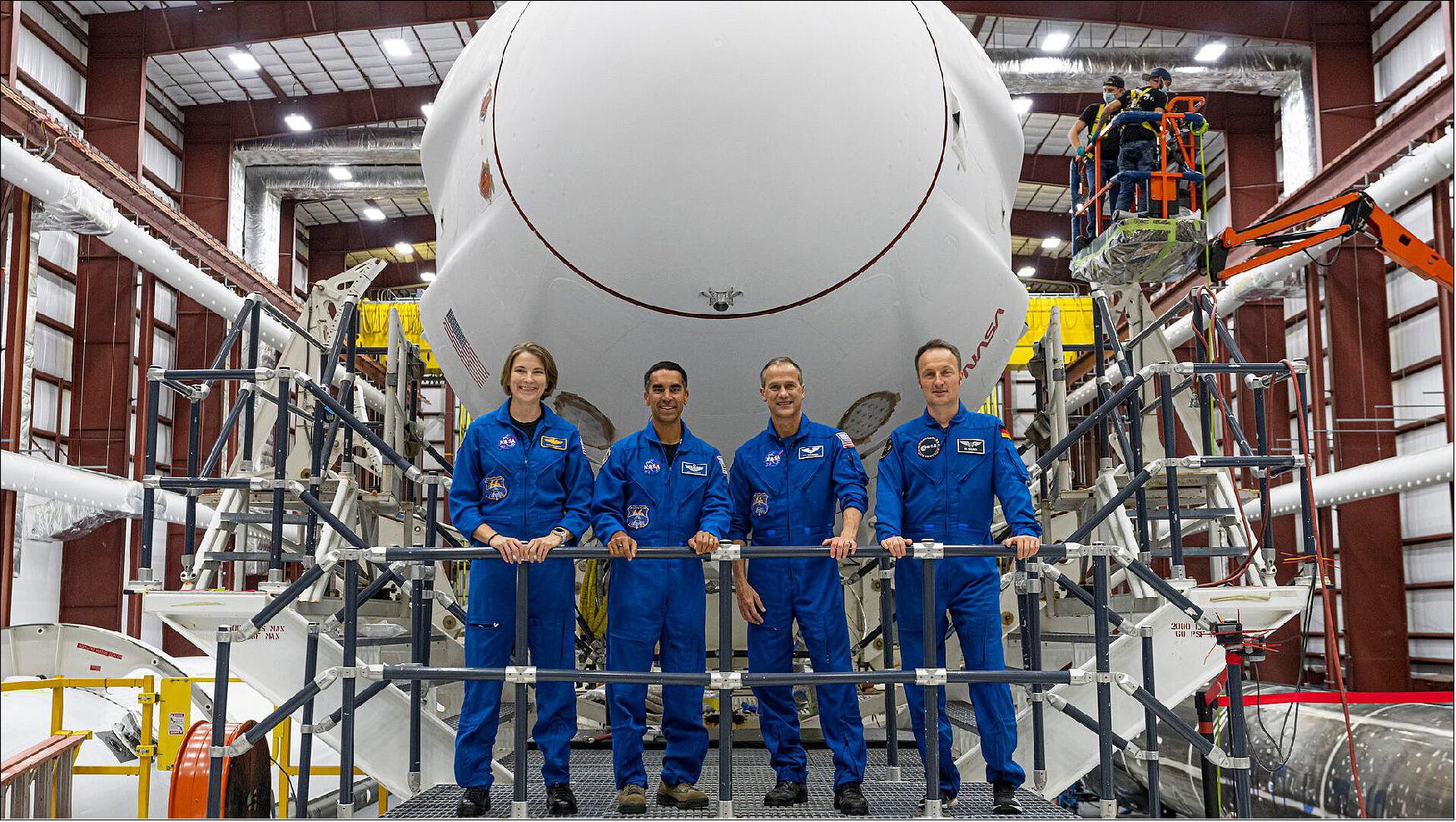
Launch
The Crew-3 mission was launched on 11 November 2021 at 02:03 UTC (9:03 p.m. EST on 10 November) on a SpaceX Falcon 9 rocket from Launch Complex 39A at NASA’s Kennedy Space Center in Florida. 6)
The SpaceX Falcon 9 rocket propelled the Crew Dragon Endurance spacecraft with NASA astronauts Raja Chari, Tom Marshburn, and Kayla Barron, as well as ESA (European Space Agency) astronaut Matthias Maurer, into orbit to begin a six-month science mission on the space station.
This mission is the first spaceflight for astronauts Chari, Barron, and Maurer, and the third for Marshburn. Marshburn is the sixth person to launch from Earth on three different spacecraft.
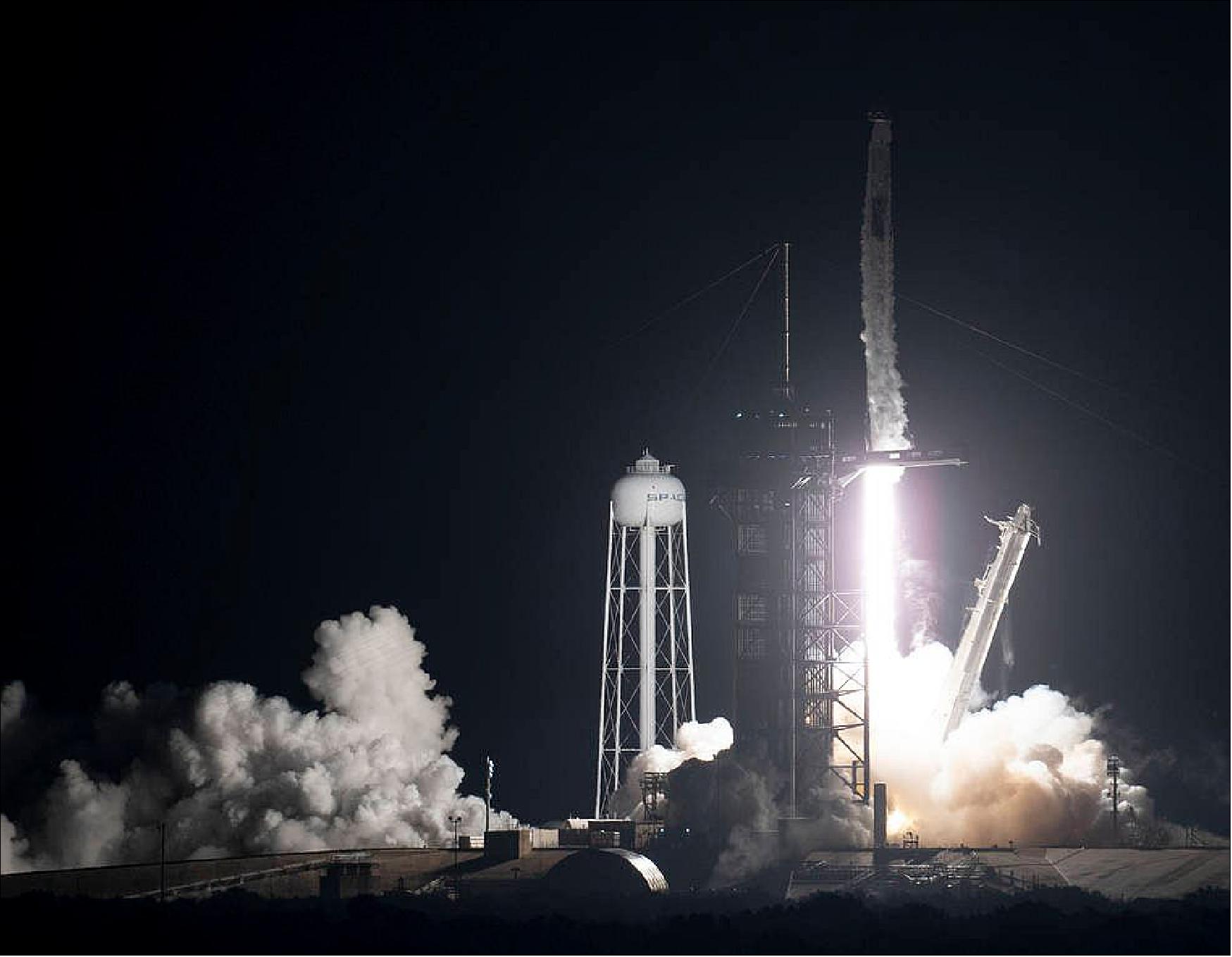
Orbit: Near-circular orbit, altitude of ~ 400 km, inclination of 51.6º.
Chari, Marshburn, Barron, and Maurer will join the Expedition 66 crew of NASA astronaut Mark Vande Hei and cosmonauts Anton Shkaplerov and Pyotr Dubrov of Roscosmos. Crew-3 is the second commercial crew mission to fly an ESA astronaut.
Matthias’s six-month Cosmic Kiss mission officially begins when he enters the Station, where he and his Crew-3 crewmates will be welcomed by Russian cosmonauts Anton Shkaplerov and Pyotr Dubrov and NASA astronaut Mark Vande Hei (Ref. 5).
Anton is the current commander of the International Space Station. He took over the role from ESA astronaut Thomas Pesquet on 6 November, prior to Thomas’s return to Earth with Crew-2.
Cosmic Kiss is the first space mission for Matthias, who graduated as an ESA astronaut in 2018. Matthias will spend approximately six months supporting science and operations aboard the orbital outpost and is expected to perform a Russian spacewalk in support of the European Robotic Arm (ERA) activation, having certified in both the Russian Orlan and American Extravehicular Mobility Unit (EMU) spacesuits.
Overview 7)
Once in orbit, the crew and SpaceX mission control will monitor a series of automatic maneuvers that will guide the Crew-3 astronauts to their new home in orbit at the forward end of the station’s Harmony module.
Crew Dragon astronauts are slated to arrive at the space station tomorrow, Nov. 11, with docking targeted for 7:10 p.m. EST. Following docking and hatch opening, a welcoming ceremony is planned for 9:20 p.m. EST. The spacecraft is designed to dock autonomously with the ability for astronauts aboard the spacecraft to take control and pilot manually, if necessary.
After successfully docking, the astronauts of Crew-3 will be welcomed to station by the Expedition 66 crew, including the Crew-2 astronauts still aboard. After a short handover period, Crew-2 astronauts will board Crew Dragon Endeavour for their return to Earth in early November.
The Crew-3 astronauts will spend approximately six months aboard the International Space Station conducting new and exciting scientific research in areas such as materials science, health technologies, and plant science to prepare for human exploration beyond low-Earth orbit and benefit life on Earth.
Fiber Optic Production-2 (FOP-2) builds on previous work to manufacture commercial optical fibers in microgravity using a blend of elements called ZBLAN. Earlier studies suggest that ZBLAN optical fibers produced in microgravity exhibit qualities superior to those of fibers produced on Earth. Results from FOP-2 could help further verify these studies and aid in the development of manufacturing processes of high value optical fiber aboard the space station for commercial use.
The rHEALTH ONE Microgravity Demonstration focuses on the functionality and performance of this modified commercial off-the-shelf device’s underlying technology to complete flow cytometry of selected control solutions. Flow cytometry can provide quick and accurate measurements of biological indicators related to disease, infection, or environmental exposure while in microgravity. Successful in-orbit testing of the device would be an important step toward providing this capability for deep-space exploration missions.
The eXposed Root On-Orbit Test System (XROOTS) investigation uses hydroponic and aeroponic techniques to grow plants without soil or other growth media. Plants are monitored through their entire life cycle. Results could identify suitable methods to produce crops on a larger scale for future space missions.
Approximately 70% of astronauts experience eye changes during long-duration space missions. The changes are collectively referred to as Spaceflight Associated Neuro-ocular Syndrome (SANS). The European Retinal Diagnostics experiment will use a commercially available ophthalmology lens, adapted for use with a tablet in space, to capture images of astronauts’ retinas. The images and videos collected will be used to test and train AI models that could automatically detect retinal changes in astronauts in the future, and provide the ability to support patients and clinicians on Earth in remote or developing regions.
During their stay aboard the orbiting laboratory, astronauts of Crew-3 will see cargo spacecraft including the SpaceX cargo Dragon in December and the Northrop Grumman Cygnus in early 2022. They will also welcome two different private crews to the station, including Japanese tourists aboard a Russian Soyuz spacecraft at the end of 2021, and the Axiom Mission 1 crew, the first private astronaut mission to the International Space Station, scheduled to launch no earlier than February 21, 2022. The Crew-3 astronauts are scheduled to conduct a series of spacewalks to outfit the station’s power system in preparation for new solar arrays that will increase the station’s total available power supply.
At the conclusion of the mission, Crew Dragon will autonomously undock with the four astronauts aboard, depart the space station and re-enter Earth’s atmosphere. After splashdown just off Florida’s coast, a SpaceX recovery vessel will pick up the crew and bring them back to shore to board a plane for return to NASA’s Johnson Space Center in Houston.
The Crew-3 mission continues the efforts of NASA’s efforts to restore and maintain American leadership in human spaceflight. Regular, long-duration commercial crew rotation missions enable NASA to continue the important research and technology investigations taking place aboard the station. Such research benefits people on Earth and lays the groundwork for future exploration of the Moon and Mars starting with the agency’s Artemis missions, which includes land the first woman and person of color on the lunar surface.
Supplies and Hardware
• Aboard Dragon with the crew will be more than 400 pounds of supplies and hardware, including over 150 pounds of which they will use to conduct experiments aboard the space station. Here is some of the research riding with them into low-Earth orbit. 8)
Spacecraft Guidance in Your Pocket
- The Smartphone Video Guidance System (SVGS), created as a collaboration between NASA’s Marshall Space Flight Center in Huntsville, Alabama, and the Florida Institute of Technology in Melbourne, is about to get a test on the space station. SVGS is a low-cost, commercial-off-the-shelf implementation of advanced sensors designed for automated rendezvous and capture of spacecraft. The system uses a camera to capture images of a 4-point LED beacon and analyzes the pattern of the illuminated dots on the captured images to determine the range and orientation of the target relative to the camera frame. The system will be deployed and tested using the station’s Astrobee facility, which uses free-flying robots to test new technology and software. If successful, the software could enable future use in multi-spacecraft formations of CubeSats or other small satellites, demonstrating this technology’s potential advantages in other robotic proximity operations such as rendezvous and docking.
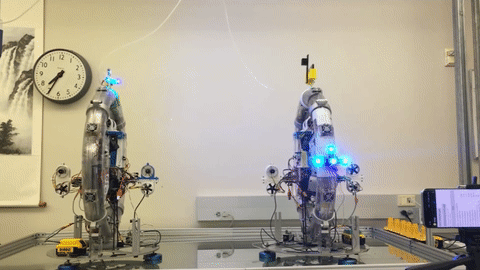
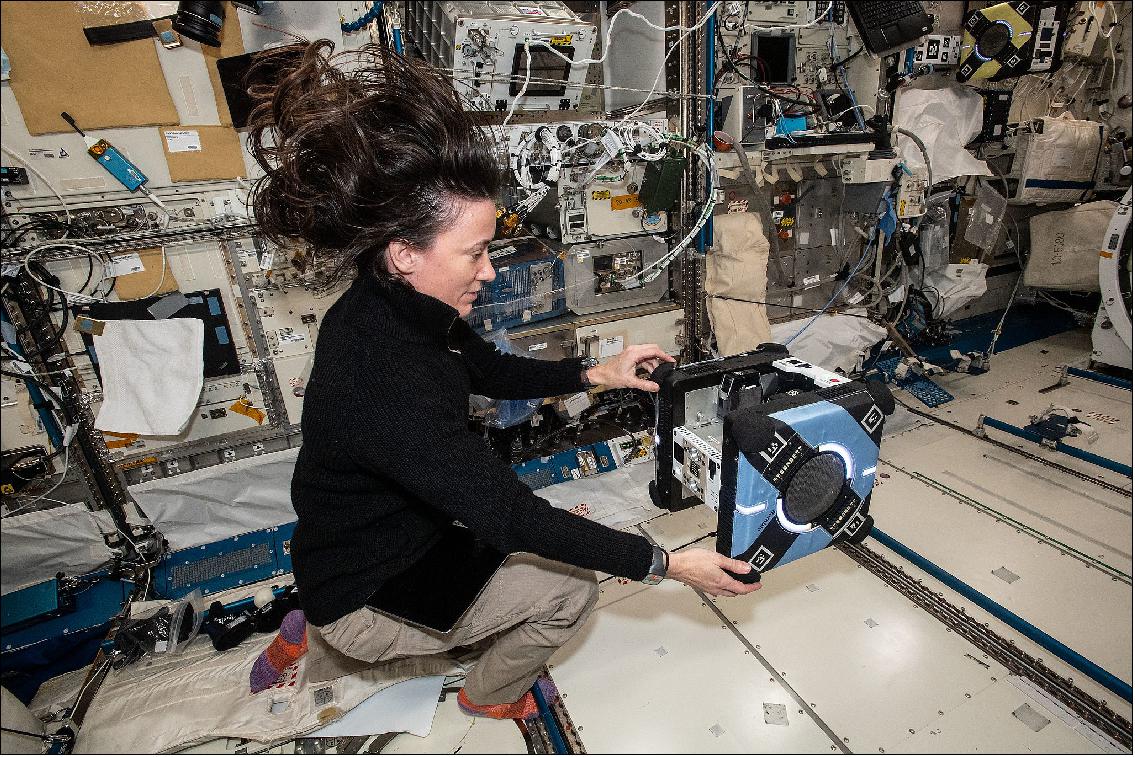
- “Key factors that make SVGS attractive to small sat applications also make it appealing to human exploration missions, where crew spacecraft need to dock with a variety of platforms,” says SVGS Principal Investigator Dr. Hector Gutierrez of the Florida Institute of Technology. “The niche for a proximity operations sensor for space applications is currently open. The demonstration of SVGS on the space station is an important milestone to position SVGS in that role.”
Better Space Diets
- Spaceflight affects human bodies in numerous ways, including how the immune system functions. The Food Physiology investigation documents if the effects of dietary improvements will also improve immune function and the gut microbiome and if those improvements can help crews better adapt to spaceflight. An enhanced understanding of food’s effects on physiology in microgravity can help scientists continue to improve the spaceflight diet and crew health.
- Resupply hardware for the Food Physiology study launches on the Crew Dragon spacecraft along with the Crew-3 astronauts. Once in orbit, the astronauts will collect biological samples to provide data to the scientists back on the ground for continued study of how dietary changes affect living in microgravity.
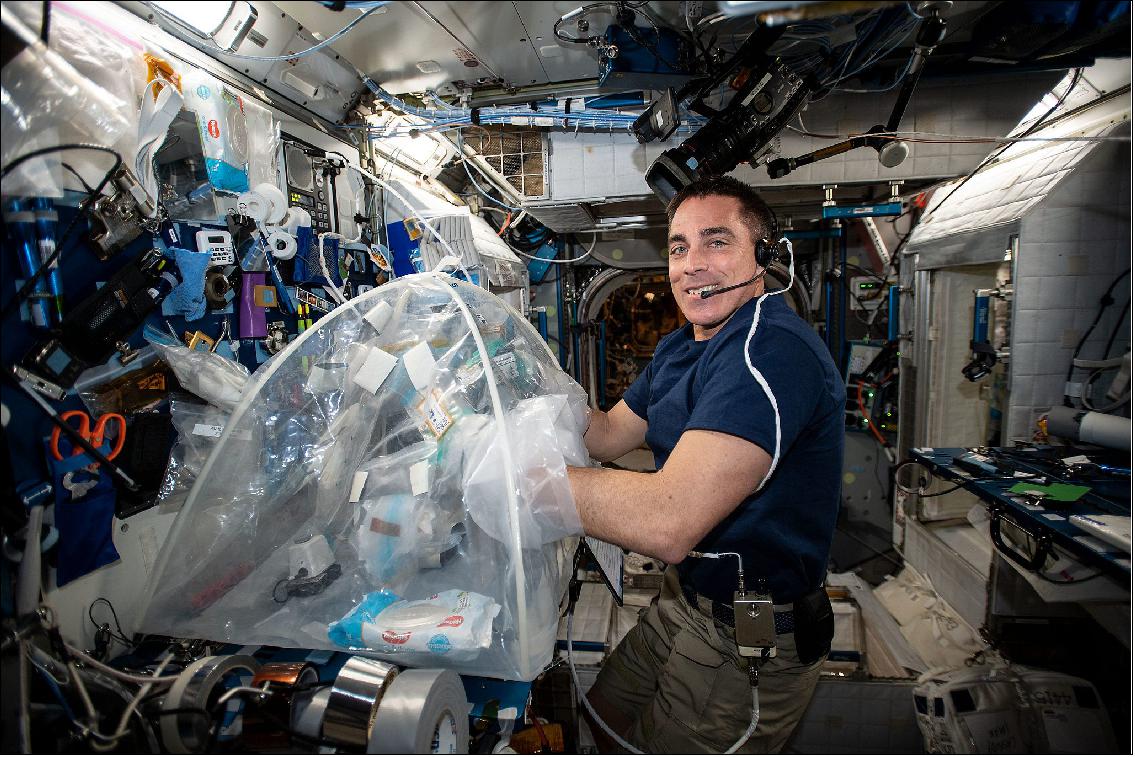
Crystal Clear
- Uniform Protein Crystal Growth (UPCG) is planned to launch aboard Crew-3 and return to Earth soon after with Crew-2. The study aims to leverage this quick turnaround and microgravity to grow a batch of near perfect nanocrystals of riboswitch RNA, which is responsible for switching individual genes on and off. Once returned aboard a different Crew Dragon spacecraft, researchers plan to quickly analyze these nanocrystals using the X-ray Free-Electron Laser (XFEL), a powerful atomic imaging technology that allows users to create a movie of the structural changes taking place during a critical process that lasts only milliseconds. This process has not been observed due to the inability to grow large enough crystals on the ground. Findings could help researchers better understand the process of gene switching as well as advance the XFEL technology itself, which has potential applications in biotechnology and medicine.
Monitoring Astronaut Health For Science
- Spaceflight Standard Measures (SSM) is a set of consistent biological core measurements taken from space station crew members to characterize the effects of living and working in space. Standard measures include physiological, psychological, and chemical measurements that quantify crew or subject health and performance before, during, and after flight. The data is archived and made available for many future studies that can improve understanding about how the human body adapts to microgravity. Additional supplies for this experiment will launch with Crew-3, who will then participate in the data collection aboard station.
Efficient Exercise
- On Earth, our muscles constantly must work against gravity, which allows them to grow stronger or maintain strength naturally. To prevent muscle atrophy and the resulting bone loss in microgravity, astronauts on the space station exercise for around two and a half hours every day. The ESA study EasyMotion wants to increase the efficiency of this exercise using electrical muscle stimulation (EMS), a strengthening technique in which muscles are stimulated by applying electrical impulses. EasyMotion combines targeted exercises with the underlying muscle tension achieved using EMS to increase the efficiency of exercise. On the space station, Maurer will use a specialized EMS suit launching with Crew-3 aboard Dragon to complement his exercise program of running, cycling, and strength training.
- In addition to the experiments flying with them aboard Dragon, the Crew-3 astronauts are scheduled to conduct many additional experiments and technology demonstrations during their mission. Crew-3 is crucial for the testing of new upgrades to the space station’s Environmental Control and Life Support System (ECLSS), including the newly installed toilet, the Brine Processing Assembly, carbon dioxide scrubbers, and two new hydrogen sensors slated to arrive aboard a SpaceX Cargo Dragon in late December. They also plan to test the printing of fiber optics and a handheld bioprinter and to study concrete hardening among some of the more than 200 investigations during their time in orbit.
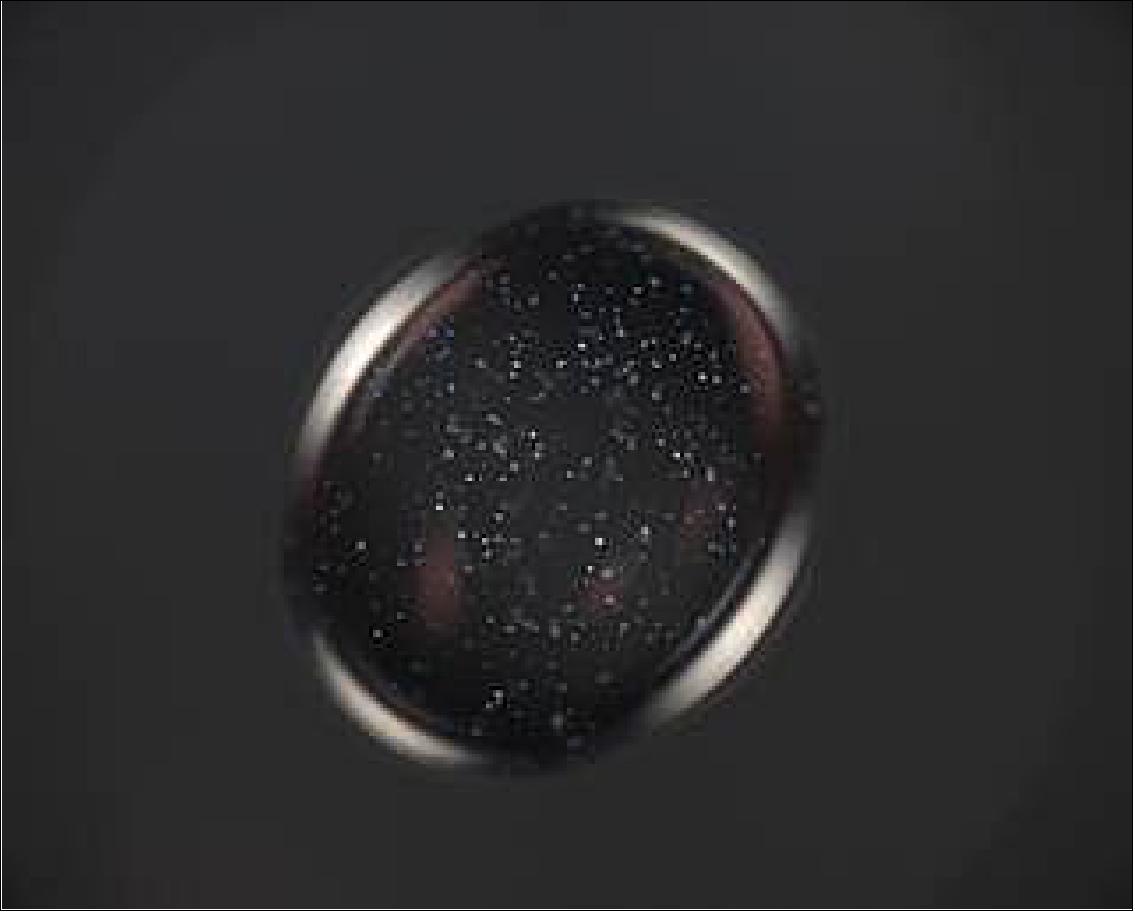
Science in Space
• With a background in materials science Matthias is looking forward to supporting over 35 European and many more international experiments in orbit. These include investigations in human research, biology, materials science, fluid physics, environmental science and radiation, and technology. A few highlights include (Ref. 5):
- Retinal Diagnostics, which uses a commercially available ophthalmology lens, adapted for use with a tablet in space, to capture images of astronauts’ retinas. Images and videos collected will be used to test and train artificial intelligence (AI) models that could automatically detect retinal changes in astronauts in the future and provide the ability to support patients and clinicians on Earth in remote or developing regions.
- Biofilms, which aims to determine which metal surface has the best anti-microbial properties on ground, in orbit or on Mars. Run in the Kubik facility – a temperature-controlled incubator for studying biological samples in Europe’s Columbus module – it will test the growth of bacteria such as human skin-associated bacteria Staphylococcus capitisunder microgravity conditions.
- EasyMotion, which will see Matthias test a specialized electrical muscle stimulation (EMS) suit while exercising to determine its effect in mitigating muscle and bone loss in microgravity.
Figure 9: Cosmic Kiss mission patch. The name of European Space Agency (ESA) astronaut Matthias Maurer’s first mission to the International Space Station, Cosmic Kiss, is a declaration of love for space. It communicates the special connection the Station provides between Earth’s inhabitants and the cosmos. It also conveys the value of partnership in exploring farther to the Moon and Mars, alongside the need to respect, protect and preserve the nature of our home planet as we seek a sustainable future on Earth. - The Cosmic Kiss patch takes inspiration from the Nebra sky disc (“Himmelsscheibe von Nebra”) – the oldest known realistic illustration of the night sky – as well as the Pioneer plaques and Voyager Golden Records that were sent into the unknown carrying messages from Earth. These artefacts show a fascination with space that spans the ages. Since the beginning of time, humans have looked skyward for knowledge about the origins of life, the Universe and our place in the cosmos. The Cosmic Kiss mission builds on the curiosity of all those who came before us, as exploration advances our understanding of Earth, our Solar System and life itself. - Like the Nebra sky disc, the patch features several cosmic elements including Earth, the Moon and the Pleiades star cluster. It also depicts Mars, one of ESA’s three key destinations for exploration over the next 10 years, as a small red dot beckoning in the distance. - Earth is shown borderless and backlit, with only a delicate line of atmosphere visible. This phenomenon is often described by space travellers, who marvel at the wonder of all human life and events taking place in one thin and precious layer. - The most prominent feature is a simplified, almost heart-like International Space Station. This is connected through a human heartbeat that stretches from Earth to the Moon. This heartbeat symbolizes the human presence and passion that propels exploration forward and connects us to the Universe, as well as the vital life science experiments the Space Station enables. - As a unique oasis in space, the International Space Station is a hub of science, research and operations like no other. The continuous human presence that it supports beyond our Earth leads to greater knowledge, technological advances and a better understanding of fundamental and applied sciences. The Space Station is a lifeline for Earth’s future and paves the way for our next steps into space as we go forward to the Moon and Mars. It is the Cosmic Kiss that unites us and brings light to the unknown (video credit: ESA)
- The Cosmic Kiss mission patch features black, red, gold and white. Each color has been selected for its significance:
a) Black – represents the Universe and its mysteries that we seek to understand.
b) Red – stands for love and passion. It represents our human presence today and the martian soils that await us as we explore farther into the Solar System.
c) Gold – is the color of the stars that share their warmth and light to enable life.
d) White – is the heartbeat that flashes in the atmosphere. It stands for technology and scientific progress, bringing light into the dark.
Mission Status
• November 12, 2021: ESA astronaut Matthias Maurer and NASA astronauts Raja Chari, Tom Marshburn and Kayla Barron liftoff to the International Space Station in the SpaceX Crew Dragon spacecraft “Endurance”. 9)
- Collectively known as “Crew-3”, the astronauts were launched from launchpad 39A at NASA's Kennedy Space Center in Florida, USA at 02:03 GMT/03:03 CET (Central European Time) Thursday 11 November.
- Crew Dragon docking is autonomous. The spacecraft docked to the International Space Station at 00:32 CET Friday, 12 November/23:32 GMT Thursday, 11 November, marking the official start of Matthias's first mission. Once docked, astronauts on Endurance and aboard the Space Station conducted standard leak checks and pressurization before the hatch between the two spacecraft was opened at 01:25 GMT. On Station, the astronauts were greeted by their Expedition 66 crew mates, NASA astronaut Mark Vande Hei and Russian cosmonauts Anton Shkaplerov (current International Space Station commander) and Pyotr Dubrov.
- This was followed by a welcoming ceremony in which ESA Director General Josef Aschbacher and NASA Associate Administrator Space Operations Kathy Lueders wished the four astronauts all the best for science, research, and operations aboard their new home for the next six months.
Figure 10: A video of the Crew-3 flight, arrival at the ISS and ESA interview with Matthias Maurer (video credit: ESA/NASA)
• November 11, 2021: Running more than 30 minutes ahead of schedule, the SpaceX Crew-3 astronauts docked to the International Space Station at 6:32 p.m. EST Thursday on 11 November, less than 24 hours after launching from the Kennedy Space Center in Florida. NASA astronauts Raja Chari, Tom Marshburn, Kayla Barron, and ESA (European Space Agency) astronaut Matthias Maurer opened the hatch of their Crew Dragon spacecraft Endurance at 8:25 p.m. and participated in a welcome ceremony with their new Expedition 66 crewmates at 9 p.m. 10)
- On board to welcome them were fellow astronaut Mark Vande Hei, Expedition 66 Commander Anton Shkaplerov and Flight Engineer Pyotr Dubrov of Roscosmos. Joining the welcome ceremony from Earth were Kathy Lueders, NASA associate administrator for Space Operations, NASA and Josef Aschbacher, ESA Director General.
- The newest crew to the microgravity laboratory is the agency’s third crew rotation mission with SpaceX and will remain on board until April 2022 as a part of Expedition 66.

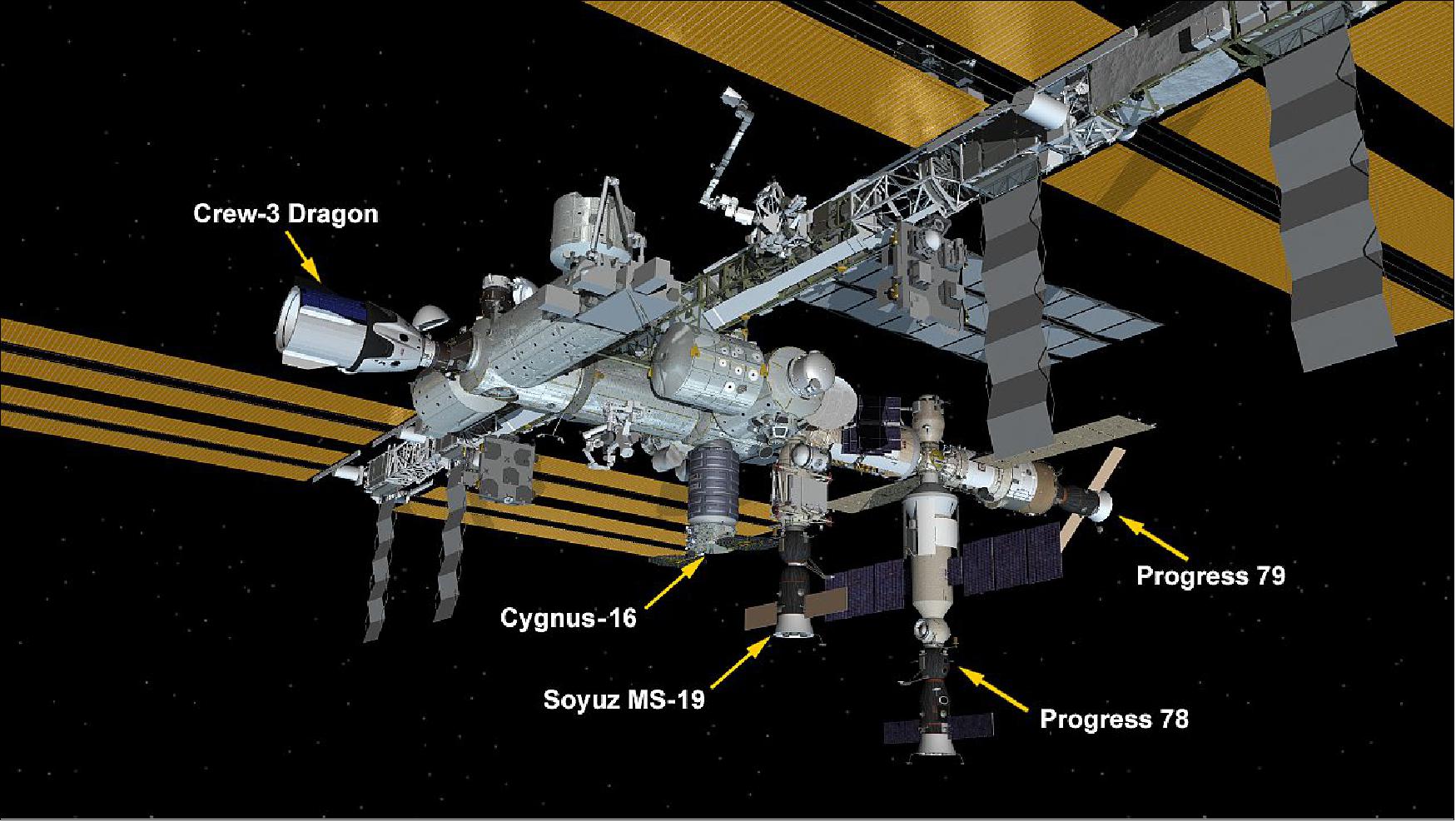
• November 11, 2021: The Crew Dragon spacecraft docked with the International Space Station Nov. 11, less than 24 hours after its launch from Florida. 11)
- The Crew Dragon spacecraft Endurance docked with the forward port of the Harmony module of the station at 6:32 p.m. EST (Eastern Standard Time). The spacecraft’s arrival to the station took place smoothly, with the docking taking place nearly 40 minutes ahead of schedule.
- Endurance delivered to the ISS the four astronauts of the Crew-3 mission: NASA astronauts Raja Chari, Tom Marshburn, and Kayla Barron, and ESA astronaut Matthias Maurer. The four will stay on the station for about six months before replaced by the Crew-4 mission in the spring of 2022.
- The mission has been closely watched on both sides of the Atlantic, as Maurer is the second of three consecutive ESA astronauts flying to the station on Crew Dragon missions. “I’m delighted to see Matthias arrive safely to the space station and wish him all the best as he, and the teams supporting him, embark on a busy six months of science, research and operations in weightlessness,” said ESA Director General Josef Aschbacher in a statement after docking.
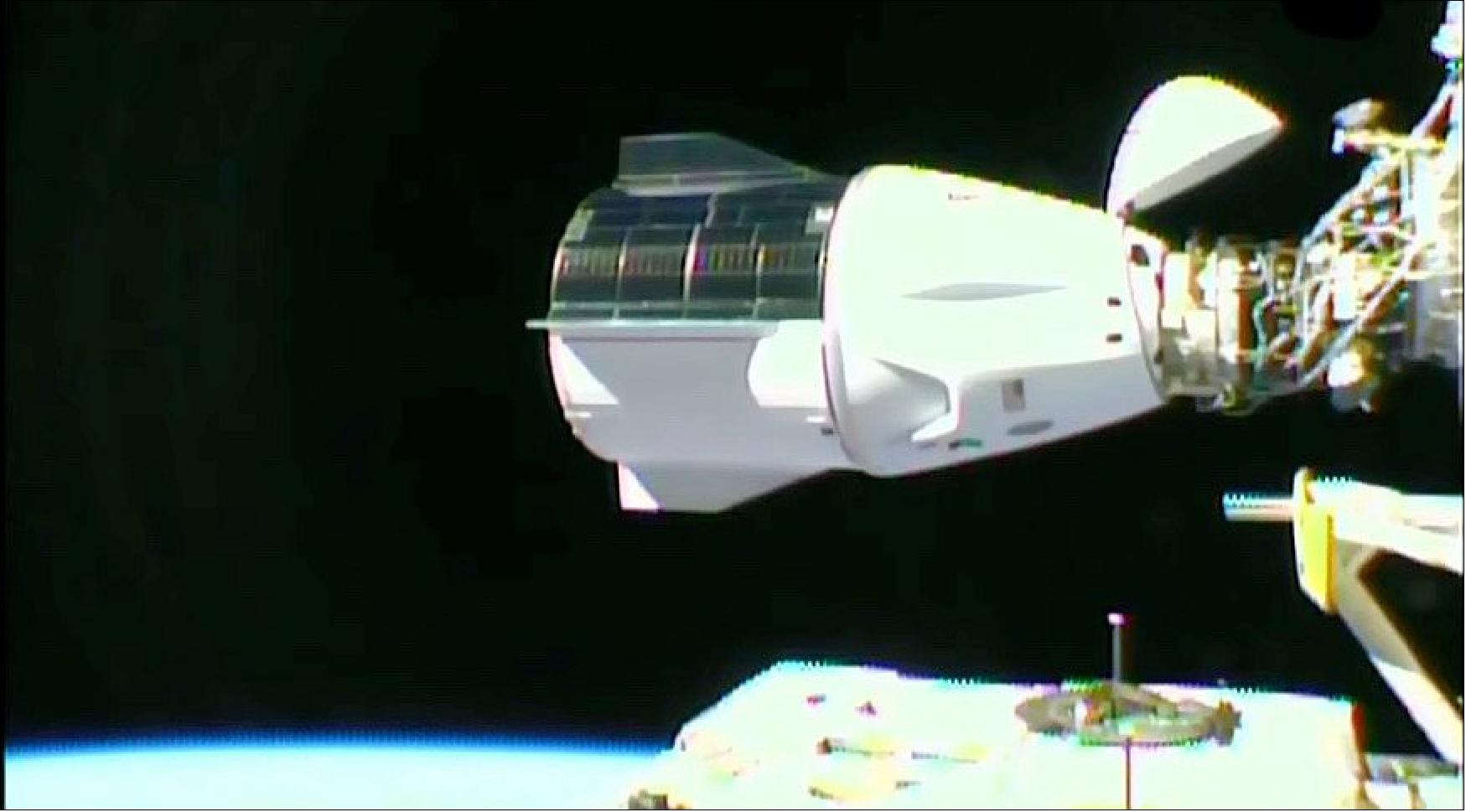
- The four join NASA astronaut Mark Vande Hei and Roscosmos cosmonauts Pyotr Dubrov and Anton Shkaplerov. Vande Hei and Dubrov have been on the station since April while Shkaplerov arrived in October. They will remain on the station until next spring.
- The seven-person ISS crew will have company over the next six months. The Soyuz MS-20 spacecraft is scheduled for launch Dec. 8 for a 12-day stay at the ISS. On board will be Roscosmos cosmonaut Alexander Misurkin and two private astronauts, Japanese billionaire Yusaku Maezawa and his production assistant, Yozo Hirano, on a dedicated commercial flight arranged by Space Adventures.
- Another Crew Dragon is scheduled to launch Feb. 21 on a flight arranged by Axiom Space. It will deliver to the station former NASA astronaut Michael López-Alegría and three private astronauts: Larry Connor, Mark Pathy and Eytan Stibbe. They will spend about a week on the station.
Some Activities of the Crew-3 Mission
• December 20, 2021: SpaceX has rolled out its Falcon 9 rocket with the Cargo Dragon vehicle attached to the launch pad at Kennedy Space Center in Florida. The Falcon 9 is due to lift off at 5:06 a.m. EST on Tuesday placing the Cargo Dragon into orbit for a docking at the International Space Station at 4:30 a.m. on Wednesday. 12)
- Expedition 66 Flight Engineers Raja Chari and Thomas Marshburn of NASA will be on duty monitoring the Cargo Dragon’s automated docking to the Harmony module’s space-facing port. Dragon is delivering about 6,500 pounds crew supplies and new science experiments including a cancer treatment study and a handheld bioprinter. Live launch coverage begins at 4:45 a.m. on Tuesday on NASA Television, the NASA app, and the agency’s website.
- The orbiting lab has returned to its occupancy rate of seven crew members after three visitors departed and returned to Earth on Sunday. Roscosmos cosmonaut Alexander Misurkin led spaceflight participants Yusaku Maezawa and Yozo Hirano inside the Soyuz MS-20 crew ship when they undocked from the Poisk module at 6:50 p.m. EST. The trio aboard the Soyuz parachuted to landing in Kazakhstan less than three-and-a-half hours later completing an 11-day station mission.
• December 20, 2021: A Soyuz spacecraft carrying a Russian cosmonaut and two Japanese private astronauts returned to Earth late Dec. 19, wrapping up a banner year for commercial human spaceflight. 13)
- The Soyuz MS-20 spacecraft undocked from the International Space Station at 6:50 p.m. EST, more than 11 days after its arrival there. It safely landed in Kazakhstan at 10:13 p.m. EST.
- The Soyuz returned to Earth Roscosmos cosmonaut Alexander Misurkin along with Japanese private astronauts Yusaku “MZ” Maezawa and Yozo Hirano. The three launched to the station on a Soyuz rocket Dec. 8 in a flight brokered by American space tourism company Space Adventures.
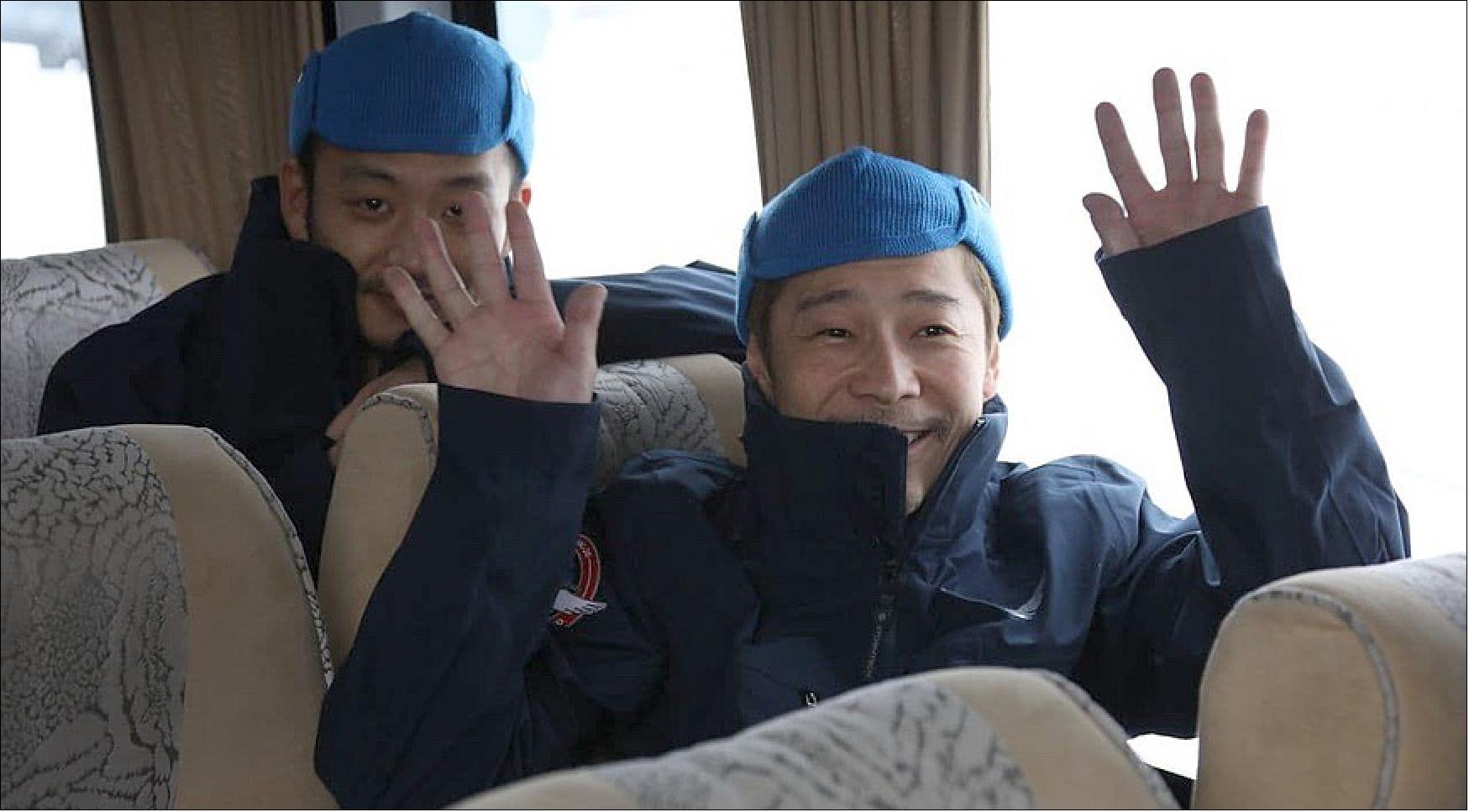
- Maezawa, the billionaire founder of fashion retailer Zozo, spent his time in space doing a series of videos about life on the station. Those activities included an ad for food delivery company Uber Eats where Maezawa, dressed like a delivery person, handed over a bag of canned foods to Misurkin. Hirano, Maezawa’s assistant, helped produce the videos.
- In an interview with The Associated Press several days after his arrival, Maezawa said he was enjoying his time in the space despite bouts of space sickness and some difficulty sleeping. “Once you are in space, you realize how much it is worth it by having this amazing experience,” he said.
- ”The completion of MZ’s spaceflight marks not only a milestone for him and Space Adventures but for the commercial spaceflight industry as a whole and humanity’s future in space,” said Eric Anderson, chief executive of Space Adventures, in a company statement. “MZ’s mission comes at the tail end of a year that saw an incredible boom in space tourism and is set to usher in another wave of exploration.”
- This year saw four organizations perform seven dedicated commercial human spaceflights. Virgin Galactic conducted two flights of its SpaceShipTwo suborbital vehicle, including one in July that carried Richard Branson about the 80-kilometer altitude that the company, and U.S. government agencies, define as space for the purposes of astronaut recognition. Blue Origin carried out three crewed flights of its New Shepard suborbital vehicle, most recently Dec. 11, taking 14 people to altitudes above 100 km. SpaceX’s Crew Dragon carried out the Inspiration4 mission in September, taking four people on a three-day orbital flight.
- The Soyuz MS-20 mission was the first dedicated private astronaut Soyuz flight to the ISS. It was also the first time Space Adventures flew people to space since 2009, when the company was selling extra seats on Soyuz taxi missions to and from the station. In October, another of those regular Soyuz taxi flights took a Russian actress and director to the station, spending more than a week there to film scenes for a movie.
- The companies involved in 2021 commercial human spaceflight have widely varying plans for 2022. Blue Origin said after its latest mission it’s expecting to conduct “several” New Shepard launches in 2022 carrying people or payloads but did not offer a more specific estimate. SpaceX’s next commercial Crew Dragon mission is the Ax-1 flight for Axiom Space to the ISS, scheduled for February. That will be followed as soon as next fall by the Ax-2 mission for Axiom.
- Virgin Galactic, however, has not flown SpaceShipTwo since Branson’s flight in July. The company is in an extended maintenance period for both SpaceShipTwo and its WhiteKnightTwo carrier aircraft and does not expect to resume commercial suborbital flights before late 2022. Space Adventures is planning another dedicated Soyuz mission to the ISS no earlier than 2023, a flight that will include an option for a customer to carry out a brief spacewalk outside the station.
• December 17, 2021: Next week will see a U.S. resupply ship launch toward the International Space Station following Sunday’s departure of three orbiting lab visitors. Meanwhile, the seven Expedition 66 crewmates continued their space biology and physics research while maintaining station systems. 14)
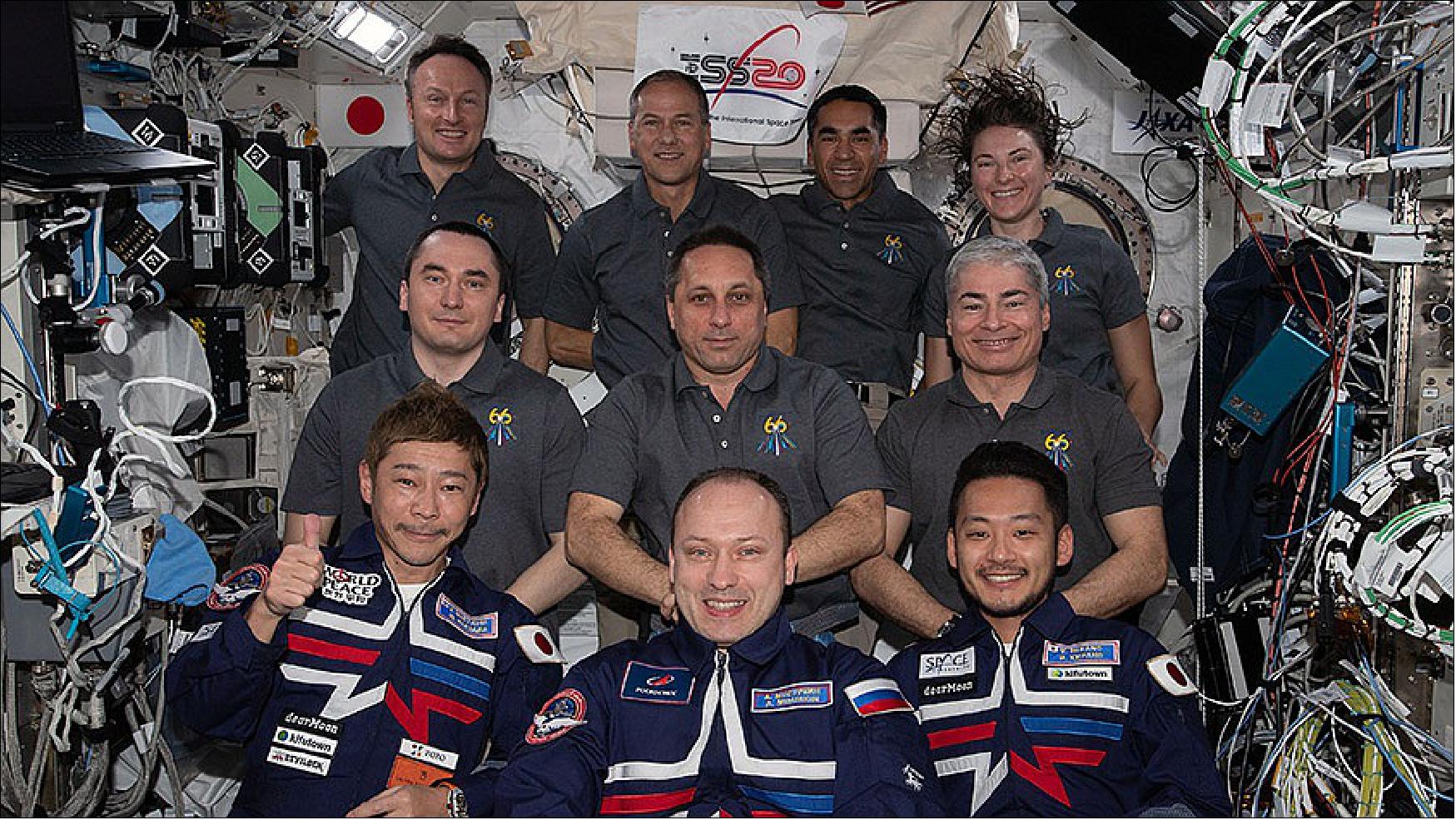
- SpaceX is due to launch its Cargo Dragon spacecraft from Florida on Tuesday at 5:06 a.m. EST to replenish the station crew. It will automatically dock to the Harmony module’s space-facing port on Wednesday at 4:30 a.m. delivering about 6,500 pounds of new science experiments, crew supplies and station hardware. NASA TV will cover both events live on the agency’s website, and the NASA app.
- NASA astronauts Raja Chari and Thomas Marshburn are training for the U.S. cargo mission. The duo reviewed Cargo Dragon’s approach and rendezvous profile and got familiarized with docked operations. Both flight engineers will be on duty Wednesday morning monitoring the commercial craft’s automated arrival and docking.
- Three space travelers are nearing the end of their 11-day mission as they prepare to return to Earth this weekend. Roscosmos cosmonaut Alexander Misurkin has been staging gear to be packed inside the Soyuz MS-20 crew ship and checking components inside the Russian spacecraft. He’ll lead Japanese spaceflight participants Yusaku Maezawa and Yozo Hirano back home when the spacecraft undocks on Sunday at 6:50 p.m. and parachutes to a landing in Kazakhstan at 10:18 p.m. NASA TV coverage begins at 3 p.m. when the departing trio says farewell to the station crew and closes the Soyuz vehicle’s hatch.
- Human research is ongoing in space as Flight Engineers Kayla Barron and Matthias Maurer began Friday with blood and saliva collections and stowed the samples in a science freezer for future analysis. Barron of NASA then spent the afternoon inspecting personal protective equipment. Maurer of ESA (European Space Agency) swapped samples for a wet foams study then configured components that support the EasyMotion space exercise suit.
- NASA Flight Engineer Mark Vande Hei continued more runs today of the InSPACE-4 manufacturing study learning how to manipulate nanoparticles in weightlessness. Vande Hei then wrapped up his day early following a busy week of space physics research taking place inside the Microgravity Science Glovebox.
- The two Expedition 66 cosmonauts, Commander Anton Shkaplerov and Flight Engineer Pyotr Dubrov, started the day attaching sensors to their hands for a muscle study. Shkaplerov then analyzed the Zvezda service module’s atmosphere and checked Russian life support and electronics hardware. Dubrov worked on communications gear and downloaded data collected from radiation detectors.
• December 9, 2021: Three individuals are adapting to life aboard the International Space Station following Tuesday’s (Dec. 7) launch and docking aboard a Russian crew ship. The seven-member Expedition 66 crew is back on science duty today while helping the new space travelers get up to speed with station systems and safety procedures. 15)
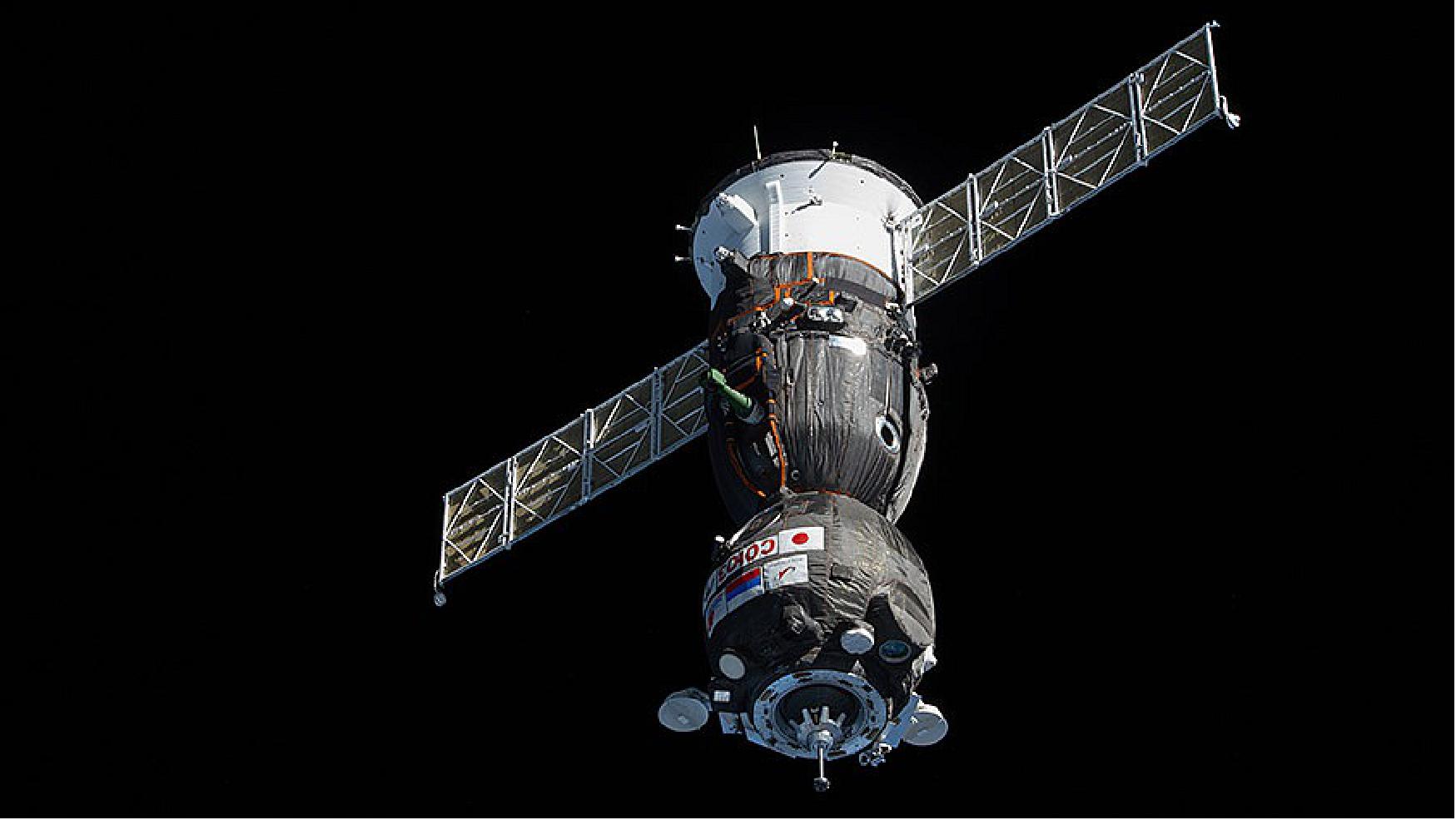
- Ten people are living on the orbiting lab today after the arrival of three space travelers on Wednesday (Dec. 8). Cosmonaut Alexander Misurkin of Roscosmos commanded the Soyuz MS-20 crew ship flanked by spaceflight participants Yusaku Maezawa and Yozo Hirano (tourists of Japan) during its six-hour and 2-minute trip from Kazakhstan to the orbiting lab’s Poisk module. The station guests will stay in space until Dec. 19 when they will undock from Poisk, reenter the Earth’s atmosphere and parachute to a landing back in Kazakhstan.
- The seven station crew members, comprised of four NASA astronauts, an ESA (European Space Agency) astronaut and two Roscosmos cosmonauts, joined their guests just before lunchtime to review emergency roles and responsibilities. All 10 lab residents spent an hour going over evacuation routes, communication procedures and other activities in response to different emergency scenarios.
- Today’s microgravity research incorporated biomedical science and space physics. NASA Flight Engineers Mark Vande Hei, Raja Chari and Kayla Barron kicked off the day with blood and urine sample collections. At the end of the day, ESA Flight Engineer Matthias Maurer scanned the eyes of Thomas Marshburn from NASA using the orbiting lab’s Ultrasound 2 device. Vande Hei also set up the Fluids Integrated Rack for a space physics study that may improve thermal systems for Earth and other planetary environments.
- Station Commander Anton Shkaplerov of Roscosmos worked throughout Tuesday on a Russian biotechnology study exploring how microbes grow in weightlessness and their impact on space systems. Flight Engineer Pyotr Dubrov photographed bacteria samples grown for the Microvir space virus investigation.
• December 8, 2021: European food has always been out of this world, but this week ESA astronaut Matthias Maurer shared a taste of his home region, Saarland – with a serving of science – during a space-based Saint Nicholas feast. 16)
- St. Nikolaus Day is widely celebrated in Germany and other parts of Europe every year on 6 December. This year it provided Matthias with the perfect occasion to share two two-course menus from his home in Saarland with his crewmates on the International Space Station.
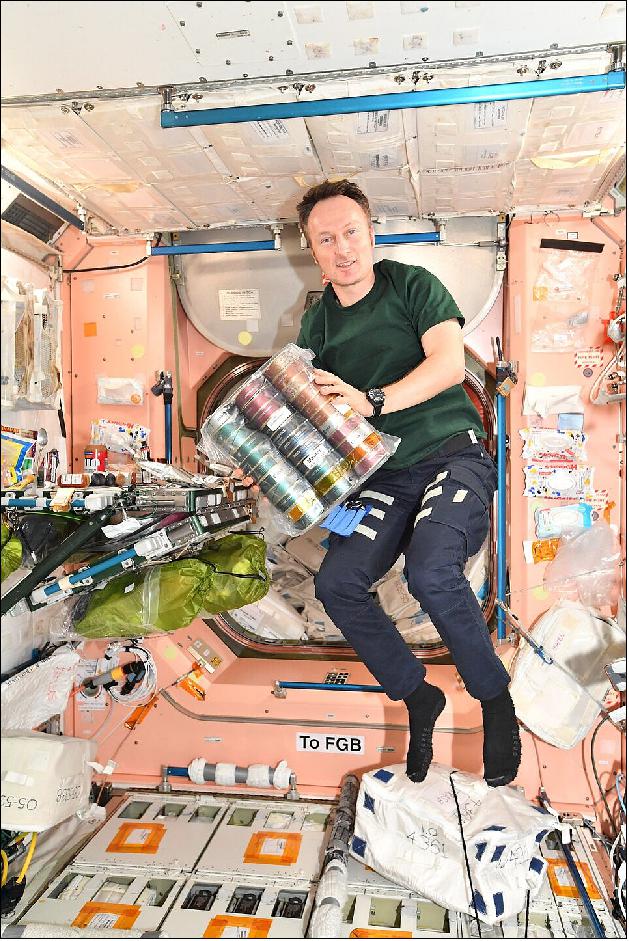
- The first of these menus was created by SR (Saarländischer Rundfunk) television and star chef Cliff Hämmerle and consisted of "Geheirade", a type of flour dumplings and boiled potatoes in sauce, and Rostige Ritter (French toast) for dessert. The second menu came from the winner of an online voting competition that the Saarland Tourist Board announced in 2020, in which 10 chefs proposed dishes.
- The winner of this competition was the owner and chef of the Taverne Roemische Villa Borg in Saarland, Christian Heinsdorf. His menu consisted of a cream of potato soup and venison stew with creamed wild mustard and hoorische, a type of potato dumpling. ESA then worked with certified catering company LSG Group to prepare and preserve both menus for space.
- “We ate all four cans per person for dinner,” Matthias says. “Everyone indulged fully in the culinary highlights of my home region. I also invited them to Saarland to try out more dishes. I hadn’t actually tried the space-versions of these dishes either because I wanted to have the full surprise in orbit, and I have to admit the chefs did a great job!
- “The potato soup was a bit less liquid than on the ground but that was on purpose to avoid spilling the soup out of the can in 0 g. The Geheirade and the Rostige Ritter tasted as I remember them. The potato soup and venison were new to me, but I look forward to trying the originals at Taverne Roemische Villa Borg when I return to Earth.”
Clever Cutlery
- Food was not the only touch of Saarland present at the festive feast. The astronauts also ate with special spoons made of stainless steel and copper. These spoons are part of an investigation into the antimicrobial properties of laser-structured surfaces.
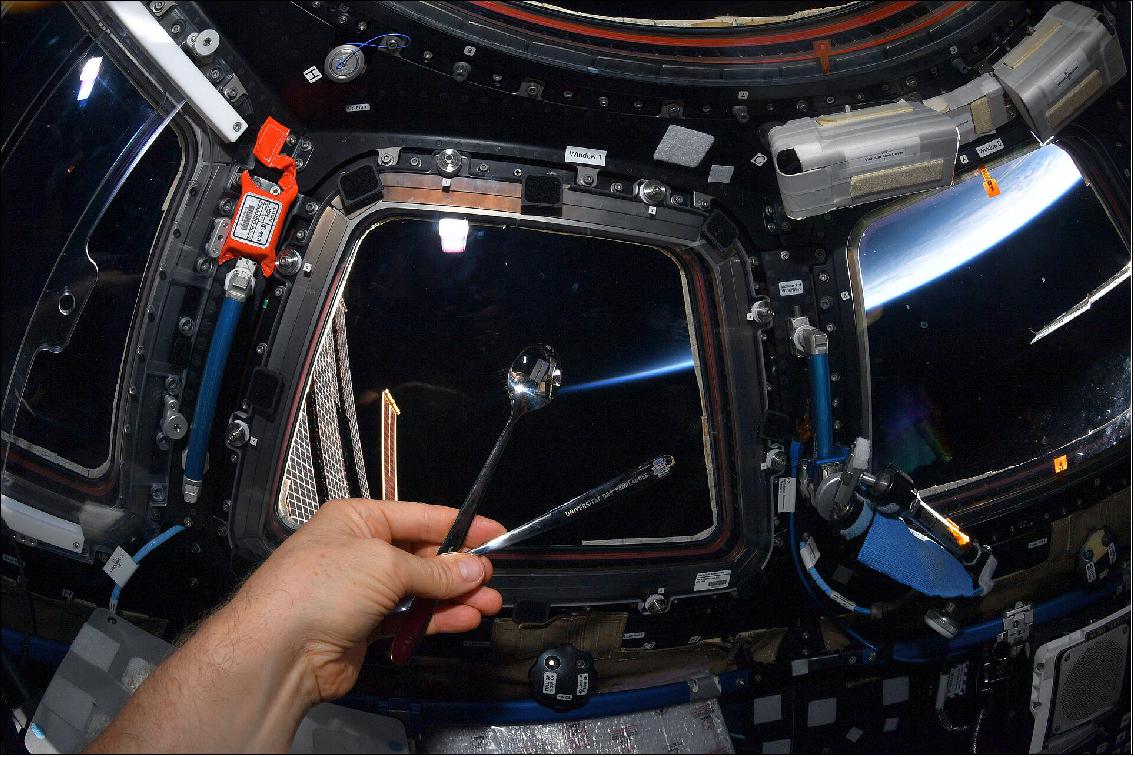
- Principal investigators Ralf Möller of the Institute of Space Medicine, German Aerospace Center, Cologne and Frank Mücklich from the Institute for Functional Materials, Saarland University have been jointly investigating the antimicrobial effect of laser-structured surfaces for use during space travel since 2017. Though the antimicrobial effect of some metals has been known for a while, modern laser surface structuring is thought to result in up to 80% less bacterial adhesion and could significantly reduce the transmission of harmful germs both in space and here on Earth.
- Ralf and Frank describe the aim of the spoons experiment as “to find out how efficiently spoons with surfaces made of stainless steel or copper and additionally defined periodic, microscopically fine laser structures prevent the accumulation of microorganisms or even kill them, when they adhere to them, and how robust the structured surfaces are in everyday use.”
- Matthias and his crew mates were asked to use the spoons as much as possible, with only a light cleaning between individual use before they are returned to Earth for analysis.
- Though they hope the spoons will help shed light on the best materials for safer surface, Ralf says the subject of whether food tastes better on Saarland cutlery could remain up for debate.
- “We will ask Matthias after the flight whether the food tastes better with the Saarland high-tech spoons. But here we may encounter some bias,” he jokes.
- In his initial reports Matthias says, “The small surface treated test areas on the spoons didn’t change any eating sensation – on the contrary, using these surface treated spoons made the eating event even more special.”
• December 3, 2021: At 1:58 a.m. CST, 2:58 a.m. EST this morning (07:58 UTC), the Russian Progress 79, attached to the space station, fired its thrusters for 2 minutes and 41 seconds to slightly lower the station’s orbit. This maneuver provided a healthy margin of separation from a fragment of Pegasus rocket debris (object 39915) that ballistics specialists have been tracking. The Expedition 66 crew aboard the station is not in any additional danger. 17)
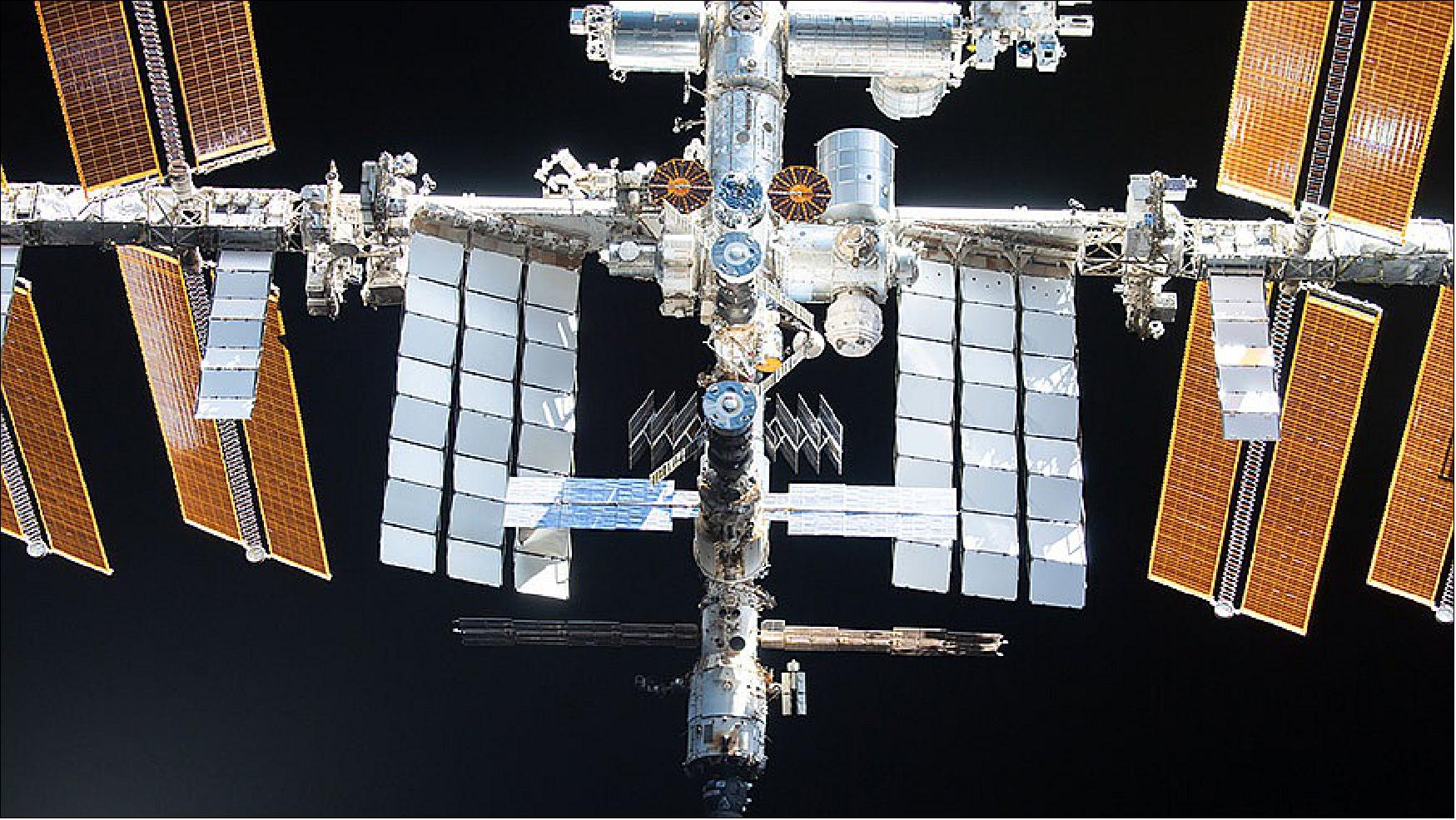
- The Pre-determined Debris Avoidance Maneuver (PDAM) was coordinated between NASA flight controllers, Russian ballistics officials, and the station’s other international partners.
- The station’s orbit has been lowered by 3/10 of a mile at apogee and 4/10 of a mile at perigee. The current orbit is 262.6 x 258.8 statute miles (422.6 x 416.5 km).
- Object 39915 was a piece of debris generated during the breakup of object 23106 (Pegasus R/B). The launch occurred on May 19, 1994, and the breakup of the rocket’s upper stage occurred on June 3, 1996. Locate more information about how NASA manages the risk of orbital debris at: https://www.nasa.gov/mission_pages/station/news/orbital_debris.html
• December 2, 2021: Barely three weeks into space life, first-time flyer Matthias Maurer has operated a robotic arm, welcomed a docking module, slept in a brand-new bed and changed plans a few times due to space debris alerts. Even science has not been routine, as he ran a handful of experiments for the very first time in orbit. 18)
- ESA’s current astronaut-in-residence arrived at the International Space Station on 12 November in a Crew Dragon spacecraft for his six-month Cosmic Kiss mission.
- Matthias, who is the 600th human to fly to space, is now well-adjusted to his ‘space legs’.
- During November, he handled the Station’s 17-m-long robotic arm, Canadarm2, to release the Cygnus spacecraft and prepared to do so again on 2 December to assist spacewalkers from inside the Space Station. Piloting the arm requires mental gymnastics to understand the motion in weightlessness.
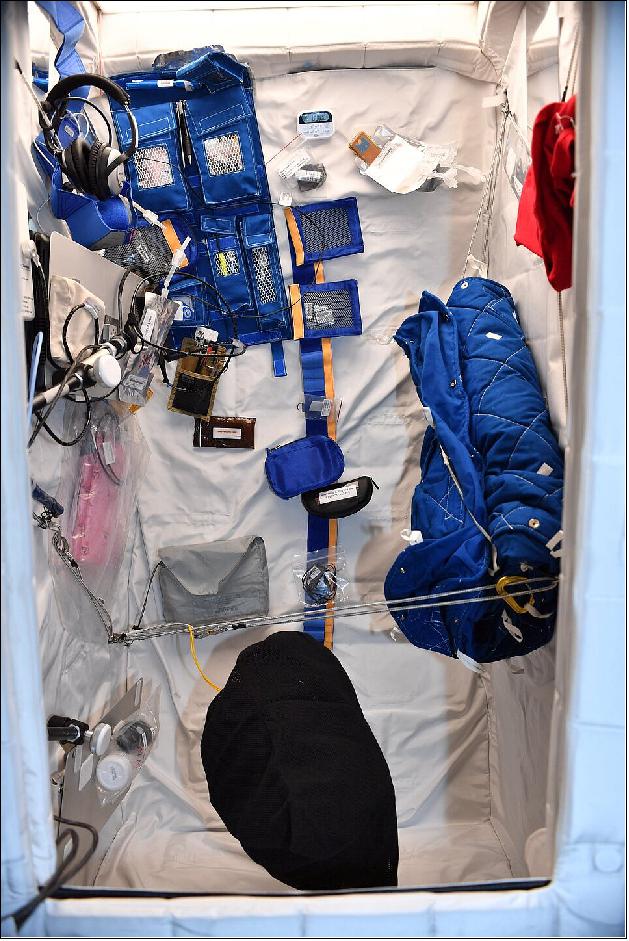
- Space life also requires quality sleep. Matthias had his bed set-up by fellow ESA space traveller Thomas Pesquet, who made sure ventilation and noise levels were pleasant in Europe’s Columbus laboratory for him.
- Another quiet place in the space quarters is the new module on the block, Prichal. The latest Russian node adds up to six more docking ports to the Station. And, because it has no active components, it is nice and calm inside.
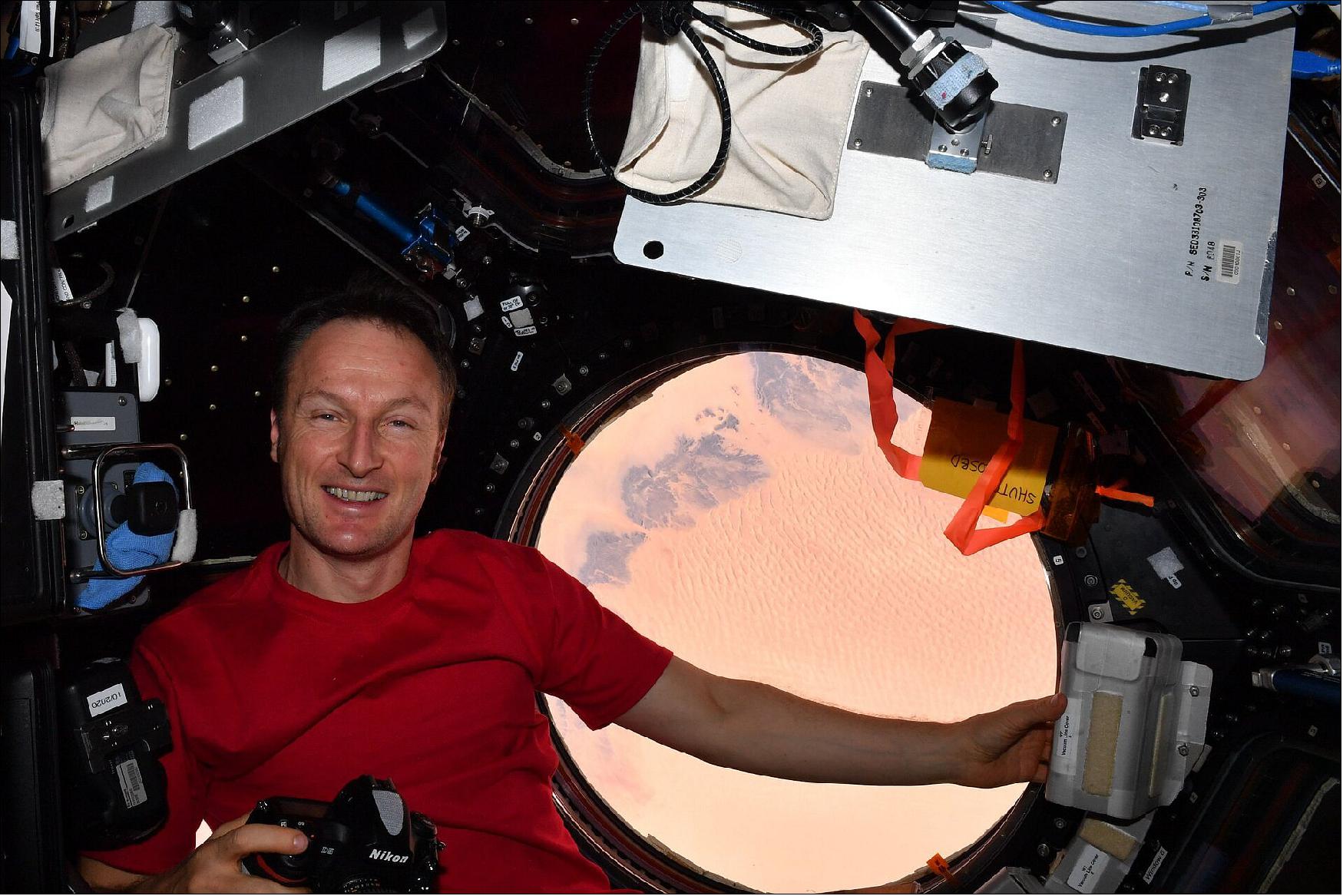
A New Space Scientist
- Matthias is supporting a wide range of European and international science experiments and technological research on the Station.
- Like on the ground, microbial contamination is a concern in space. The Touching Surfaces experiment exposes a series of five panels, made of different materials, to the indoor environment of the Space Station. Matthias and his fellow astronauts are encouraged to touch these panels frequently before they are returned to Earth for analysis. Scientists will then look at how microorganisms stick to these panels, and for how long. Results could aid development of novel antimicrobial surfaces for the health care sector and food industry.
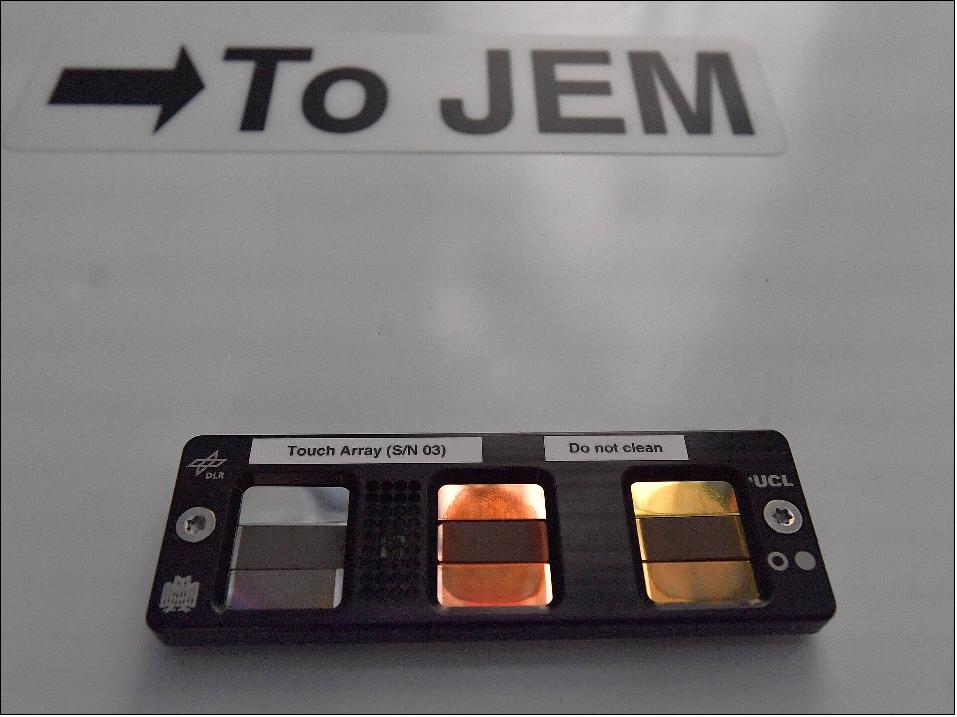
- Matthias’s body was also the subject of several science studies. While a thermal sensor strapped to his forehead monitored his core temperature and circadian rhythm for the Thermo-Mini experiment, the Retinal Diagnostics study captured images of his eyes to detect any vision pathologies common amongst astronauts.
- Matthias wore a breathing mask and two devices on his chest filled with sensors during a static bike ride. The wireless devices monitored his heart rate, oxygen and carbon dioxide levels for the Metabolic Space experiment, a technology demonstration to improve cardiopulmonary diagnostics and assess performance in space without restricting mobility.
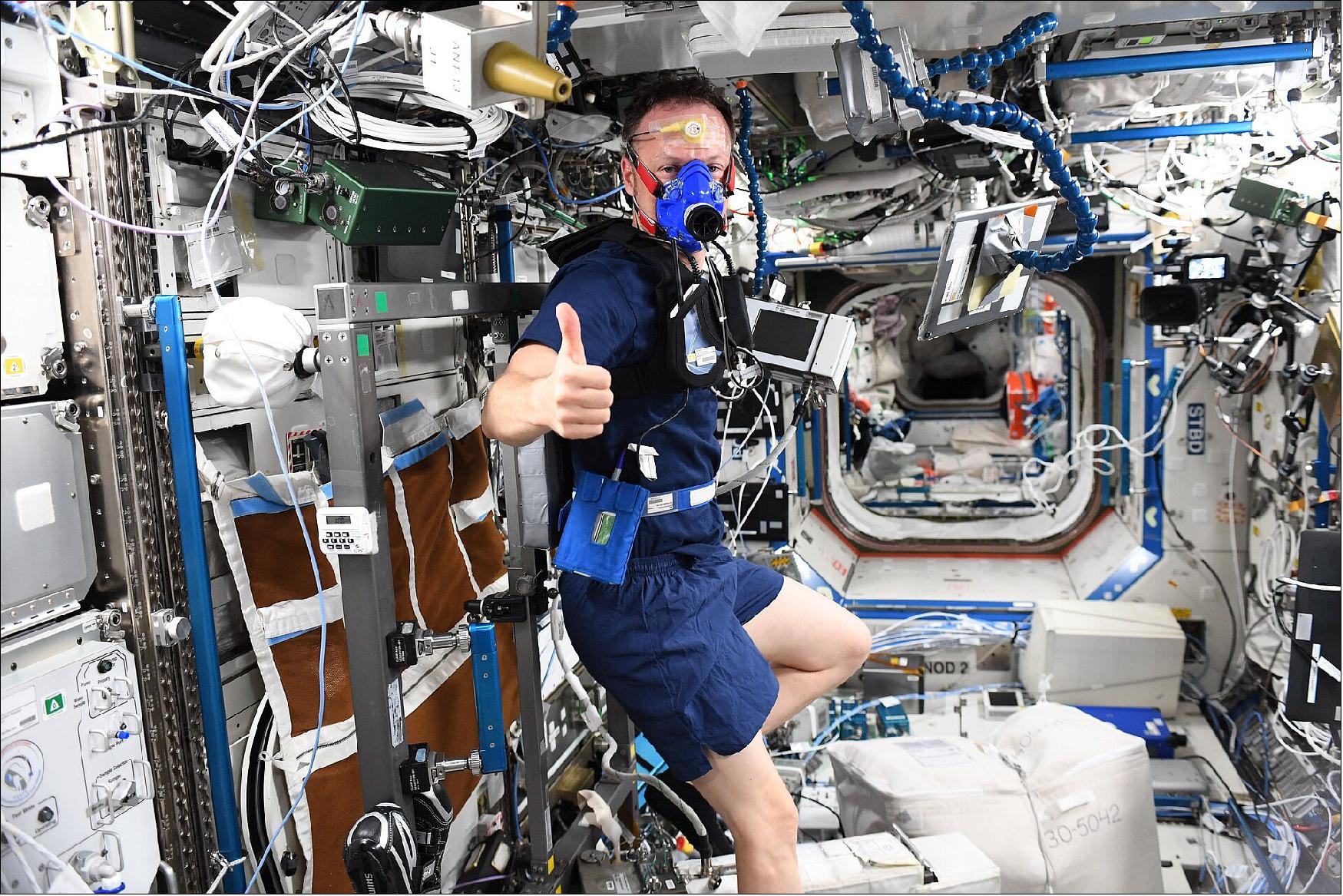
Old Friends
- A familiar experiment on the Station that monitors muscle tone and stiffness during spaceflight, Myotones, joined forces with a new study to improve exercise outcomes. The EasyMotion experiment uses a wearable electro muscle stimulation (EMS) suit that activates the musculature and has the potential to optimize Matthias’s fitness routine in space. The combined inputs before, during and after flight of this research aim to understand the physiological strain for astronauts and could lead to new rehabilitation treatments on Earth.
- NASA crewmates Raja Chari and Kayla Barron also ran their first sessions with Grip and Grasp. These neuroscience experiments investigate how our brain takes microgravity into account when grabbing or manipulating an object. The studies help identify the workings of the vestibular system that helps us maintain balance.
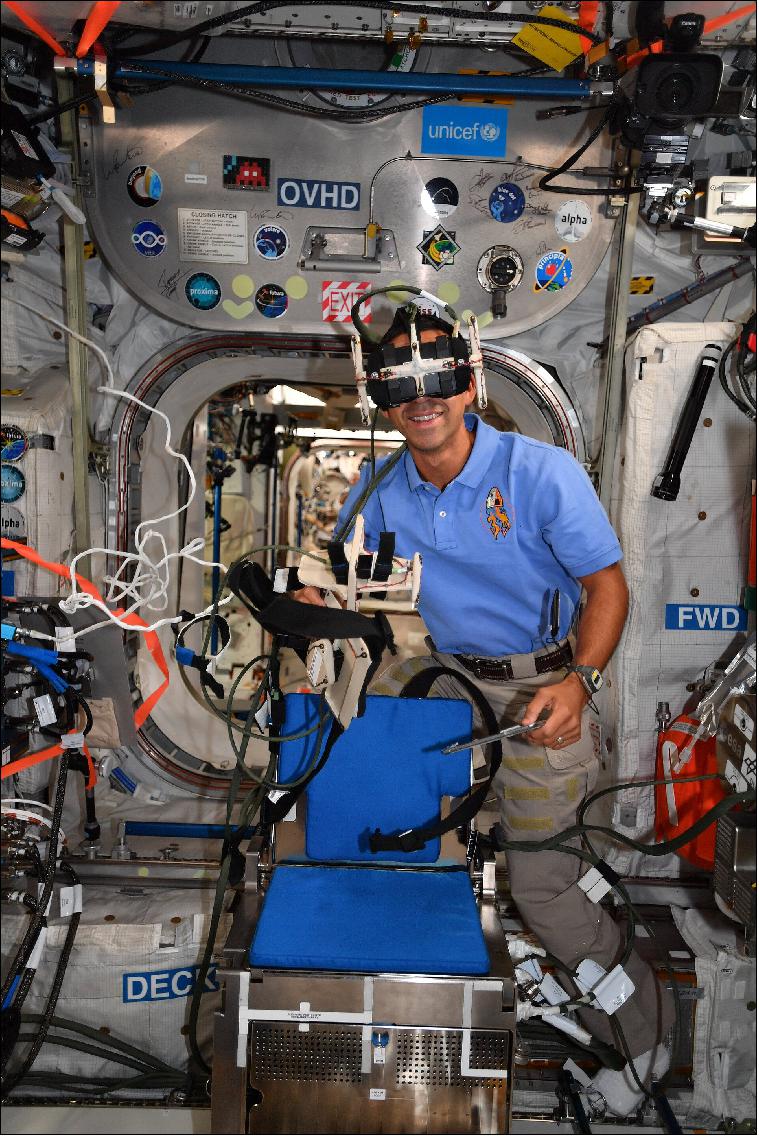
- One of the side effects of a long stay in space is the loss of bone density and muscle mass, so flight surgeons want to keep an eye on Matthias’s body changes.
- Even before enjoying his Thanksgiving dinner in space, Matthias began logging his meals to track his energy intake.
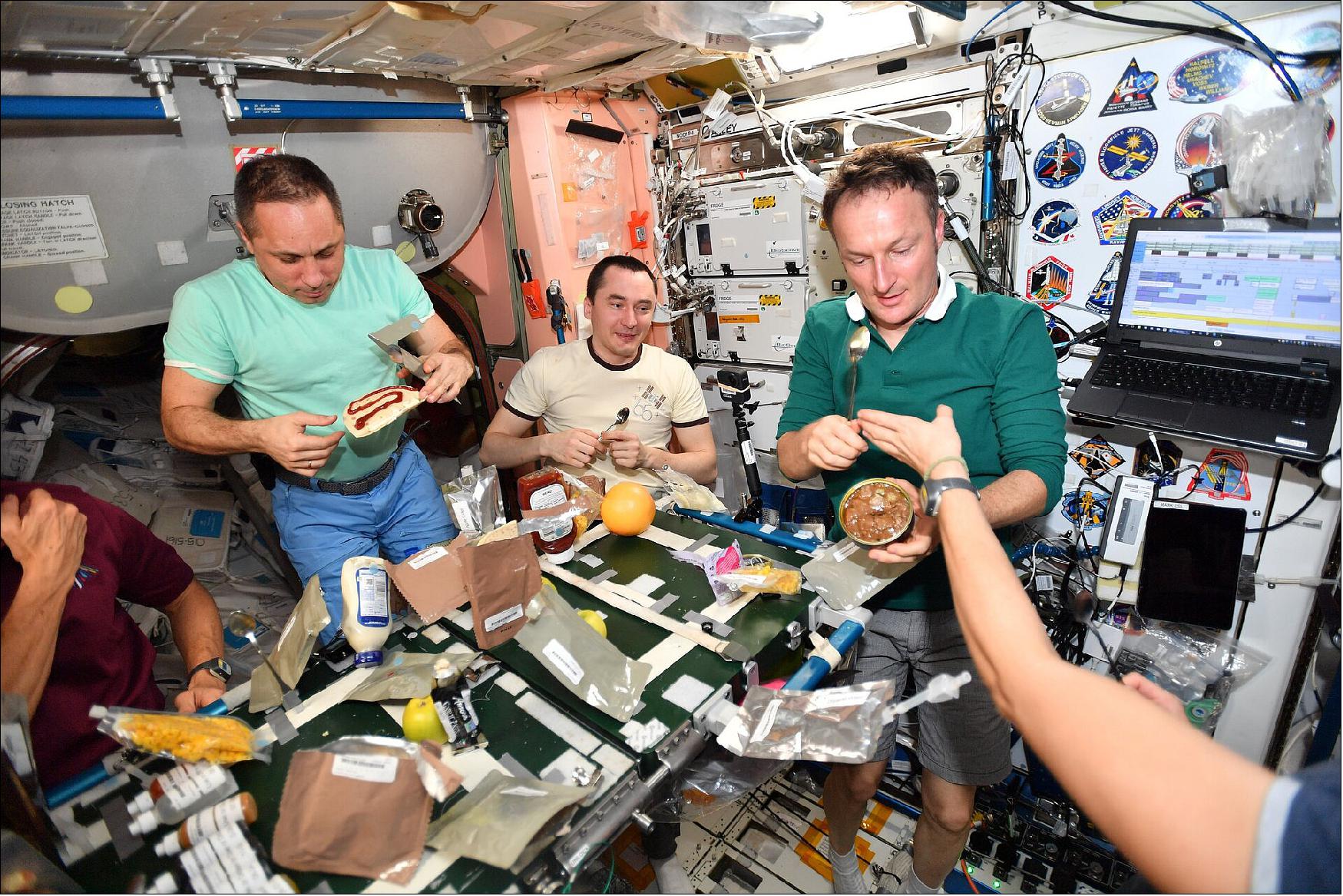
- While the NutrISS experiment assessed his nutrition, he jumped on a peculiar space scale to measure his mass in zero-g.
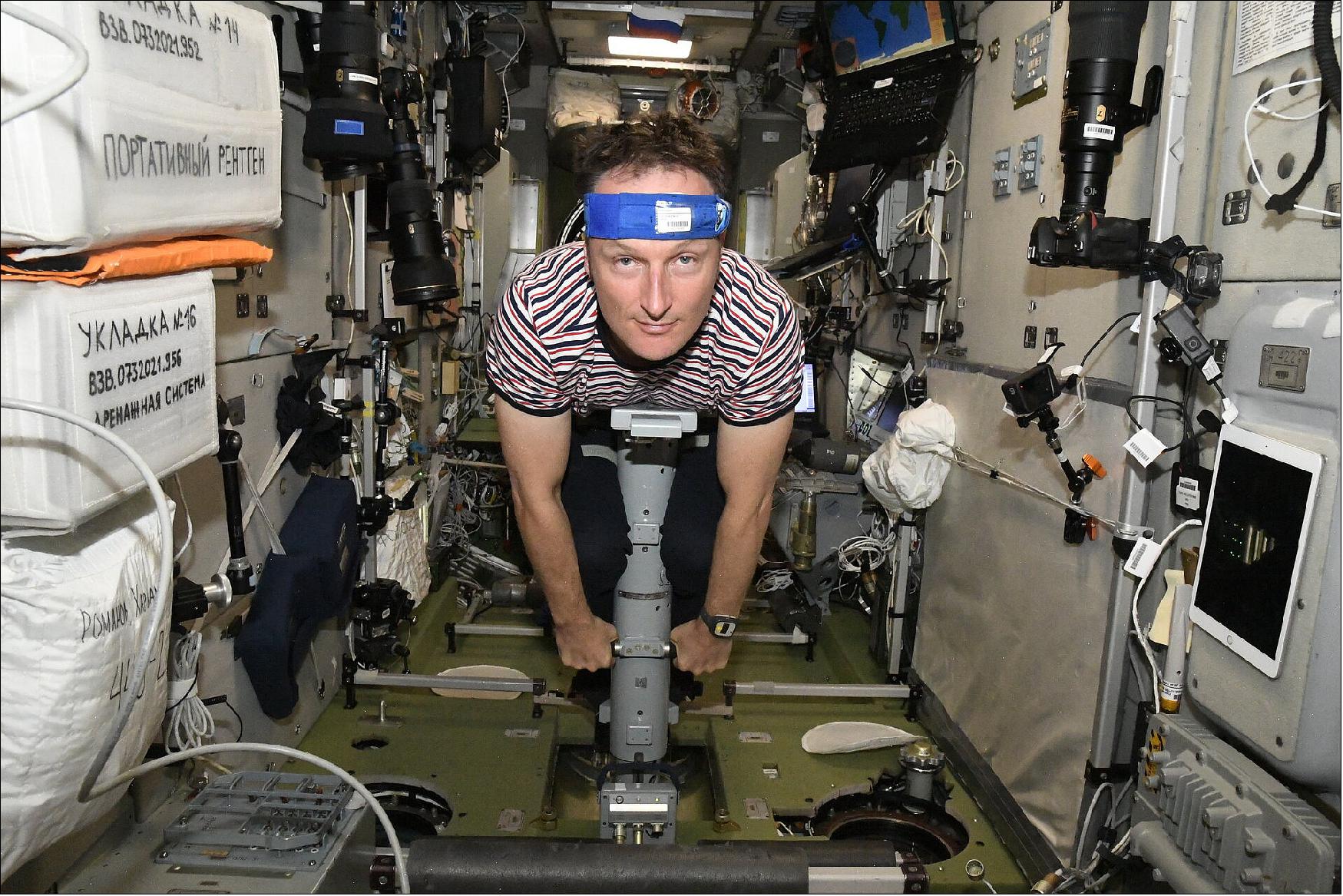
- Radiation is another well-known space hazard. Matthias dotted 21 Dosis 3D radiometers around the Station to get an overview of where radiation is most prominent. He placed 10 pouches inside the Columbus lab, and scattered a few others in other locations to build a three-dimensional map of the radiation environment.
- On the topic of space radiation, the Lumina experiment is also underway and will run kms of fibre optic cables throughout the Station to see if they are a viable technology for monitoring ionizing radiation in real-time. This technology would be useful in settings with limited habitable modules and power, like on a spaceflight to Mars.
• December 2, 2021: Flight controllers and orbital debris experts in Houston are assessing the potential risk of a piece of orbital debris from a Pegasus rocket that may pass close to the International Space Station early Friday morning (3 Dec.). Mission Control is working with NASA’s international partners to prepare for a possible debris avoidance maneuver. The closest pass is expected about 5:30 a.m. EST Friday, and the maneuver would take place about 3 a.m. if needed. The Expedition 66 crew aboard the station is not in any additional danger. Object 39915 was a piece of debris generated during the breakup of object 23106 (Pegasus R/B). The launch occurred on May 19, 1994, and the breakup of the rocket’s upper stage occurred on June 3, 1996. 19)
• December 2, 2021: NASA astronauts Thomas Marshburn and Kayla Barron concluded the first Expedition 66 spacewalk at 12:47 p.m. EST (17:47 UTC), after 6 hours and 32 minutes. 20)
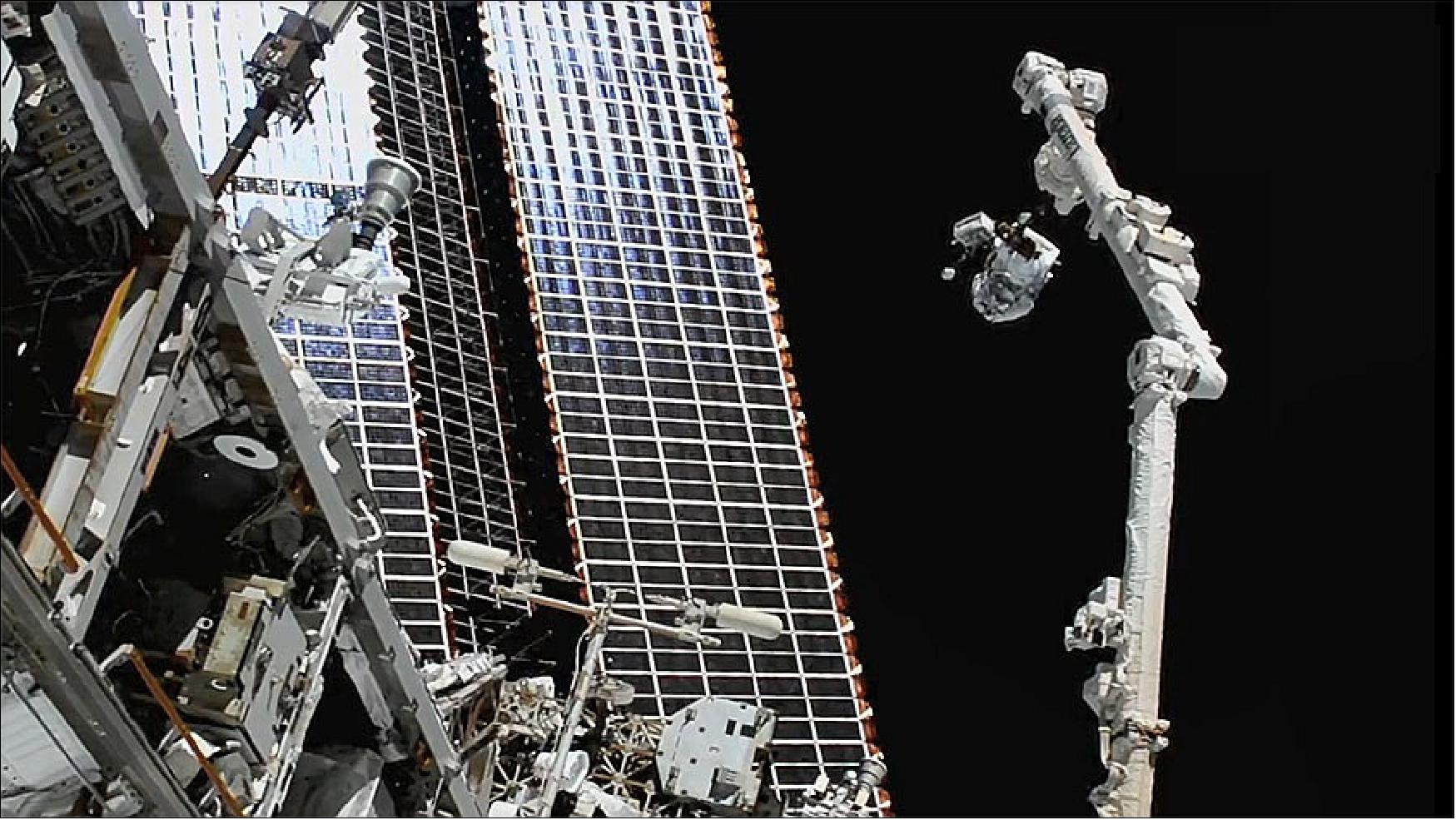
- Marshburn and Barron successfully installed an S-band Antenna Subassembly (SASA) on the Port-1 truss structure and stowed the failed antenna. Additionally, the pair completed get-ahead tasks on the Port-4 truss structure, including resetting the torque on a set of bolts.
- This was the fifth spacewalk for Marshburn, the first for Barron, and the 13th spacewalk at the International Space Station this year. Marshburn has now spent a total of 31 hours and one minute spacewalking, and Barron’s spacewalking time is now 6 hours and 32 minutes. Space station crew members have now spent a total of 64 days, 12 hours, and 26 minutes working outside the station conducting 245 spacewalks in support of assembly and maintenance of the orbiting laboratory.
- Earlier this month, the International Space Station surpassed its 21-year milestone of continuous human presence, providing opportunities for unique research and technological demonstrations that help prepare for long-duration missions to the Moon and Mars and also improve life on Earth. During that time, 249 people from 19 countries have visited the orbiting laboratory, which has hosted nearly 3,000 research investigations from researchers in 108 countries and areas.
• May 2, 2022: Join ESA astronaut Matthias Maurer, and his Crew-3 mates NASA astronauts Kayla Barron, Raja Chari and Thomas Marshburn, as they check out their Crew Dragon launch and entry suits before they return to Earth. 21)
Figure 28: Join ESA astronaut Matthias Maurer, and his Crew-3 mates NASA astronauts Kayla Barron, Raja Chari and Thomas Marshburn, as they check out their Crew Dragon launch and entry suits before they return to Earth (video credit: ESA/NASA)
- The spacesuits are custom-made for each crew member and protect the astronauts from potential fire and depressurisation in the crew capsule. A single connection point on the thigh, connects the spacesuits to the life support system that supplies the astronauts with oxygen and power, as well as cooling and communication systems.
- The suits are equipped with touchscreen-compatible gloves and a flame-resistant outer layer and can provide pressurisation with a controlled environment for the crew in the event of cabin depressurisation. The helmets are custom manufactured using 3D-printing technology and equipped with integrated valves, visor retraction and locking mechanisms, as well as microphones.
- Crew-3 was launched to the Space Station on 11 November 2021 and will have spent approximately six months living and working in orbit before a planned splashdown off the coast of Florida, USA, in early May.
• May 3, 2022: Take a look inside the box and join ESA astronaut Matthias Maurer from a very special perspective as he supports the @DLR Mason/Concrete Hardening experiment. 22)
Figure 29: The Concrete Hardening experiment investigates the behaviour of various concrete mixtures containing cement and sand or simulated ‘Moon dust’ combined with water and various admixtures. On Earth, higher density components tend to move downward but in weightlessness they are likely to be more evenly distributed.
- Researchers will analyse the concrete mixed by Matthias in space for strength, bubble and pore distribution as well as crystal structures, comparing this to ground samples. Their findings will facilitate the development of new, improved concrete mixes that could be used to construct habitats on the Moon or Mars and build more sustainable housing on Earth.
• May 4, 2022: NASA will provide live coverage of the upcoming return activities for the agency’s SpaceX Crew-3 mission. The mission will depart from the International Space Station with NASA astronauts Kayla Barron, Raja Chari, and Tom Marshburn, as well as ESA (European Space Agency) astronaut Matthias Maurer. 23)
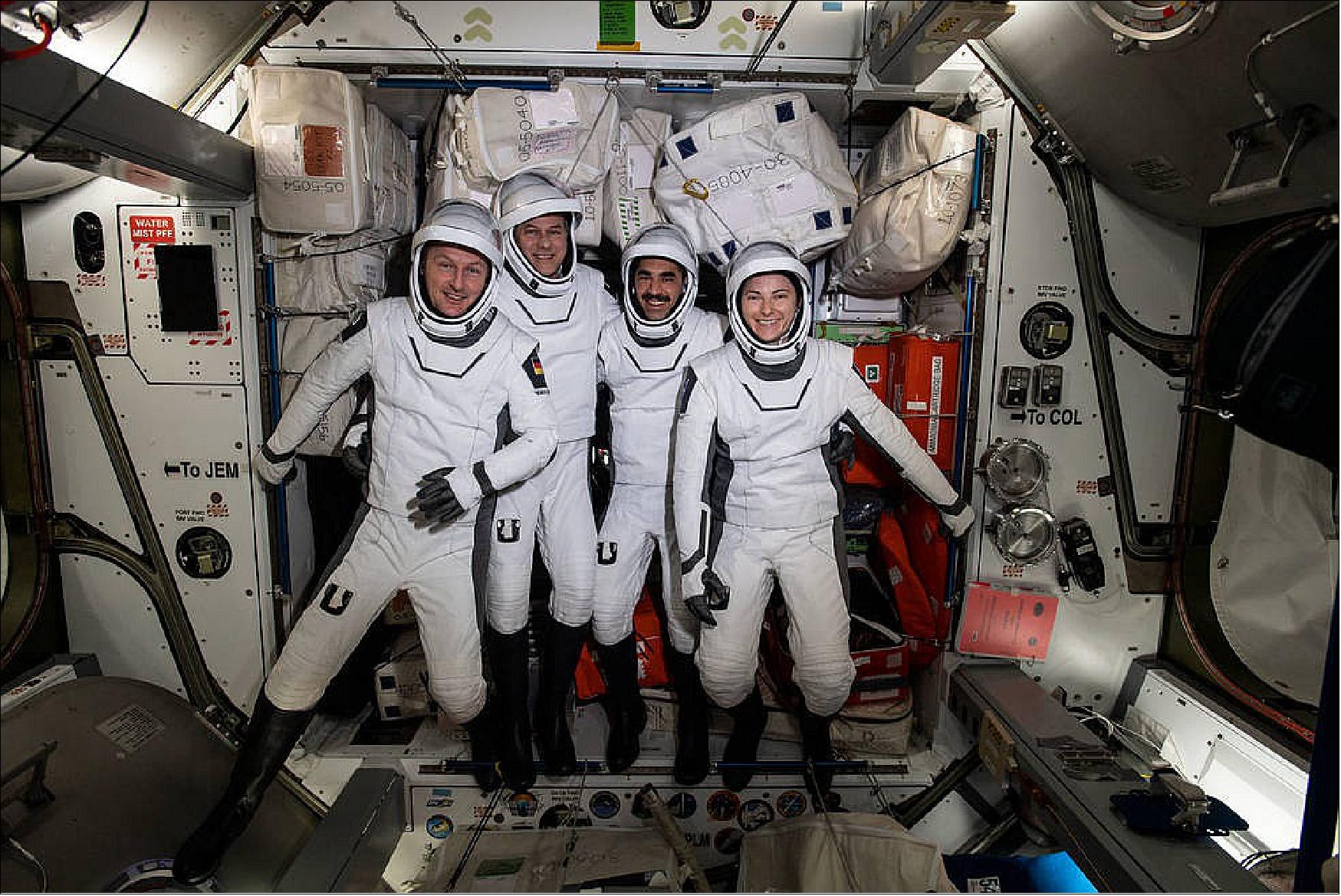
- NASA and SpaceX are targeting 12:43 a.m. EDT on Friday, May 6, for the splashdown and conclusion of the Crew-3 flight, wrapping up a nearly six-month science mission. The spacecraft is scheduled to undock from the space station to begin the journey home at 1:05 a.m. on Thursday, May 5.
• May 6, 2022: NASA’s SpaceX Crew-3 astronauts aboard the Dragon Endurance spacecraft safely splashed down Friday in the Gulf of Mexico off the coast of Florida, completing the agency’s third long-duration commercial crew mission to the International Space Station. The international crew of four spent 177 days in orbit. 24)
- NASA astronauts Kayla Barron, Raja Chari, and Tom Marshburn, and ESA (European Space Agency) astronaut Matthias Maurer returned to Earth in a parachute-assisted splashdown at 12:43 a.m. EDT (04.43 GMT). Teams aboard SpaceX recovery vessels recovered the spacecraft and astronauts. After returning to shore, the astronauts will fly back to NASA’s Johnson Space Center in Houston.
- “NASA’s partnership with SpaceX has again empowered us to deliver a crew safely to the space station and back, enabling groundbreaking science that will help our astronauts travel farther out into the cosmos than ever before. This mission is just one more example that we are truly in the golden era of commercial spaceflight,” said NASA Administrator Bill Nelson. “Kayla, Raja, Tom, and Matthias, thank you for your service and welcome home!”
- The Crew-3 mission launched Nov. 10 on a Falcon 9 rocket from NASA’s Kennedy Space Center in Florida. Nearly 24-hours after liftoff, Nov. 11, Endurance docked to the Harmony module’s forward space station port. The astronauts undocked from the same port at 1:05 a.m. (05: 05 GMT) May 5, to begin the trip home.
- Barron, Chari, Marshburn, and Maurer traveled 75,060,792 miles during their mission, spent 175 days aboard the space station, and completed 2,832 orbits around Earth. Marshburn has logged 339 days in space over his three flights. The Crew-3 mission was the first spaceflight for Barron, Chari, and Marshburn.
- Throughout their mission, the Crew-3 astronauts contributed to a host of science and maintenance activities and technology demonstrations. In addition, they conducted three spacewalks to perform station maintenance and upgrades outside the space station. This brought the total number of spacewalks for Marshburn to five, while Chari and Barron have each completed two, and Maurer one.
- Crew-3 built on previous work investigating how fibers grow in microgravity, used hydroponic and aeroponic techniques to grow plants without soil or other growth material, captured imagery of their retinas as part of an investigation that could detect eye changes of astronauts in space automatically in the future, and performed a demonstration of technology that provides measurements of biological indicators related to disease and infection, among many other scientific investigations. The astronauts took hundreds of photos of Earth as part of the Crew Earth Observation investigation, one of the longest-running investigations aboard the space station, which helps track natural disasters and changes to our home planet.
- Endurance will return to Florida for inspection and processing at SpaceX’s Dragon Lair, where teams will examine the spacecraft’s data and performance throughout the flight.
- The Crew-3 flight is part of NASA’s Commercial Crew Program and its return to Earth follows on the heels of NASA’s SpaceX Crew-4 launch, which docked to the station April 27, beginning another science expedition.
- The goal of NASA’s Commercial Crew Program is safe, reliable, and cost-effective transportation to and from the International Space Station. This already has provided additional research time and has increased the opportunity for discovery aboard humanity’s microgravity testbed for exploration, including helping NASA prepare for human exploration of the Moon and Mars.
• May 6, 2022: The Crew Dragon capsule carrying ESA astronaut Matthias Maurer and NASA astronauts Raja Chari, Thomas Marshburn and Kayla Barron home from the International Space Station splashed down off the coast of Florida, USA, on Friday 6 May 2022 at 05:43 BST/06:43 CEST. 25)
Figure 31: The Crew Dragon capsule carrying ESA astronaut Matthias Maurer and NASA astronauts Raja Chari, Thomas Marshburn and Kayla Barron home from the International Space Station splashed down off the coast of Florida, USA, on Friday 6 May 2022 at 05:43 BST/06:43 CEST (video credit: ESA/NASA)
- Now that his mission has come to an end, Matthias will return to ESA’s European Astronaut Centre in Cologne, Germany, where he will participate in post-flight debriefings, provide samples for scientific evaluation and readapt to Earth’s gravity with the support of ESA experts.
References
1) ”Coverage Set for NASA’s SpaceX Crew-3 Briefings, Events, Broadcasts,” NASA Press Release, 21 October 2021, URL: https://www.nasa.gov/press-release/coverage-set-for-nasa-s-spacex-crew-3-briefings-events-broadcasts
2) Crew-3 at SpaceX,” ESA Science & Exploration, 19 May 2021, URL: https://www.esa.int/About_Us/Week_in_images/Week_in_images_17_-_21_May_2021
3) ”NASA’s SpaceX Crew-3,” October 2021, URL: [web source no longer available]
4) ”Launching soon: Cosmic Kiss,” ESA Science & Exploration, 25 October 2021, URL: https://www.esa.int/ESA_Multimedia/Videos/2021/10/Launching_soon_Cosmic_Kiss
5) ”Watch live: liftoff of Crew-3 to space,” ESA Science & Exploration, 09 November 2021, URL: https://www.esa.int/Science_Exploration/Human_and_Robotic_Exploration/Cosmic_kiss/Watch_live_liftoff_of_Crew-3_to_space
6) ”NASA’s SpaceX Crew-3 Astronauts Headed to International Space Station,” NASA Press Release 21-141, 11 November 2021, URL: https://www.nasa.gov/press-release/nasa-s-spacex-crew-3-astronauts-headed-to-international-space-station
7) Mark Garcia, ”What You Need to Know about NASA’s SpaceX Crew-3 Mission,” NASA Feature, 25 October 2021, URL: https://www.nasa.gov/feature/what-you-need-to-know-about-nasa-s-spacex-crew-3-mission
8) Erin Winick Anthony, ”Crew-3 Astronauts Launch to Space Station Alongside Microgravity Research,” NASA, 26 October 2021, URL: https://www.nasa.gov/mission_pages/station/research/news/Crew-3-Launch-to-ISS-Alongside-Microgravity-Research
9) ”Throwing a Cosmic Kiss – Matthias Maurer's journey to the International Space Station,” ESA Science & Exploration, 12 November 2021, URL: https://www.esa.int/ESA_Multimedia/Videos/2021/11/Throwing_a_Cosmic_Kiss_Matthias_Maurer_s_journey_to_the_International_Space_Station
10) Norah Moran, ”The Station Crew Welcomed Four New Members,” NASA SpaceX Crew-3 Mission, 11 November 2021, URL: https://blogs.nasa.gov/crew-3/2021/11/11/the-station-crew-welcomed-four-new-members/
11) Jeff Foust, ”Crew-3 arrives at ISS,” SpaceNews, 11 November 2021, URL: https://spacenews.com/crew-3-arrives-at-iss/
12) Mark Garcia, ”Crew Gets Ready for Cargo Dragon after Visitors Leave Station,” NASA Space Station, 20 December 2021, URL: https://blogs.nasa.gov/spacestation/2021/12/20/crew-gets-ready-for-cargo-dragon-after-visitors-leave-station/
13) ”Soyuz returns from private astronaut mission to the ISS,” SpaceNews, 20 December 2021, URL: https://spacenews.com/soyuz-returns-from-private-astronaut-mission-to-the-iss/
14) Mark Garcia, ”Crew Ramps Up for Visitors’ Departure and U.S. Cargo Mission,” NASA Space Station, 17 December 2021, URL: https://blogs.nasa.gov/spacestation/
15) Mark Garcia, ”New Visitors Adapt to Station During Space Biology, Physics Research,” NASA Space Station, 9 December 2021, URL: https://blogs.nasa.gov/spacestation/2021/12/09/new-visitors-adapt-to-station-during-space-biology-physics-research/
16) ”A Saarland space feast sprinkled with science,” ESA Science & Exploration, 8 December 2021, URL: https://www.esa.int/Science_Exploration/Human_and_Robotic_Exploration/Cosmic_kiss/A_Saarland_space_feast_sprinkled_with_science
17) Mark Garcia, ”Station Separates from Debris After Orbital Maneuver,” NASA Space Station, 3 December 2021, URL: https://blogs.nasa.gov/spacestation/2021/12/03/station-separates-from-debris-after-orbital-maneuver/
18) ”Matthias launches into first month of space science,” ESA Science & Exploration, 03 December 2021, URL: https://www.esa.int/Science_Exploration/Human_and_Robotic_Exploration/Matthias_launches_into_first_month_of_space_science
19) Mark Garcia, ”Flight Controllers Assessing Debris Risk to Station,” NASA Space Station, 2 December 2021, URL: https://blogs.nasa.gov/spacestation/2021/12/02/flight-controllers-assessing-debris-risk-to-station/
20) ”NASA Astronauts Replace Antenna System Ending Spacewalk,” NASA Space Station, 2 December 2021, URL: https://web.archive.org/web/20220512024842/https://blogs.nasa.gov/spacestation/2021/12/02/nasa-astronauts-replace-antenna-system-ending-spacewalk/
21) ”Spacesuit waltz | Cosmic Kiss,” ESA Science & Exploration, 02 May 2022, URL: https://www.esa.int/ESA_Multimedia/Videos/2022/05/Spacesuit_waltz_Cosmic_Kiss
22) ”Concrete Hardening | Cosmic Kiss 360º,”ESA Science & Exploration, 03 May 2022, URL: https://www.esa.int/ESA_Multimedia/Videos/2022/05/Concrete_Hardening_Cosmic_Kiss_360
23) ”As Station Crew Readies to Return to Earth, NASA Sets TV Coverage,” NASA, 4 May 2022, URL: https://www.nasa.gov/press-release/as-station-crew-readies-to-return-to-earth-nasa-sets-tv-coverage
24) ”NASA, ESA Astronauts Safely Return to Earth,” NASA Press Release, 22-042, 06 May 2022, URL: https://www.nasa.gov/press-release/nasa-esa-astronauts-safely-return-to-earth
25) ”Crew-3 splashdown | Cosmic Kiss,” ESA Science & Exploration, 6 May 2022, URL: https://www.esa.int/ESA_Multimedia/Videos/2022/05/Crew-3_splashdown_Cosmic_Kiss
The information compiled and edited in this article was provided by Herbert J. Kramer from his documentation of: ”Observation of the Earth and Its Environment: Survey of Missions and Sensors” (Springer Verlag) as well as many other sources after the publication of the 4th edition in 2002. Comments and corrections to this article are always welcome for further updates (eoportal@symbios.space).